Malawi is home to an incredible array of birds, making it a popular destination for bird watchers and wildlife enthusiasts. With over 650 species of birds, Malawi has something to offer everyone.
From the majestic to the mysterious, the colorful and the rare, the country’s vast array of birds provide an incredible experience for those who visit. Whether you’re a beginner or an experienced bird watcher, there is something to be discovered.
From the shores of Lake Malawi to the lush grasslands and woodlands of its national parks, Malawi is home to a stunning variety of birds that will surely make your visit a memorable one.
1. Hamerkop
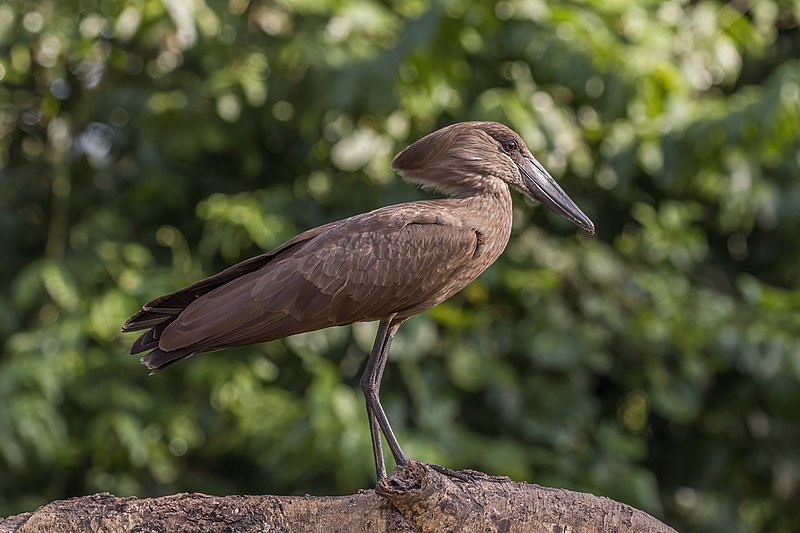
The Hamerkop is a unique wading bird found across sub-Saharan Africa and as far east as India.
It has an unmistakable silhouette, with its long bill topped by a crest at the back of its head that gives it the look of a hammerhead shark.
Its plumage consists mainly of browns and greys, providing excellent camouflage in reed beds.
The species was once classified alongside storks but is now believed to be closely related to pelicans and shoebills instead.
This medium-sized bird feeds on insects, fish, frogs or small reptiles which it captures from shallow water or plucks from trees near bodies of water.
Despite being considered ‘unlucky’ by some cultures due to superstition surrounding their appearance they are actually quite important for controlling populations of certain pests.
Scientific classification:
| Kingdom | Animalia |
| Phylum | Chordata |
| Class | Aves |
| Order | Pelecaniformes |
| Family | Scopidae |
| Genus | Scopus |
| Species | S. umbretta |
2. Böhm’s Bee-Eater
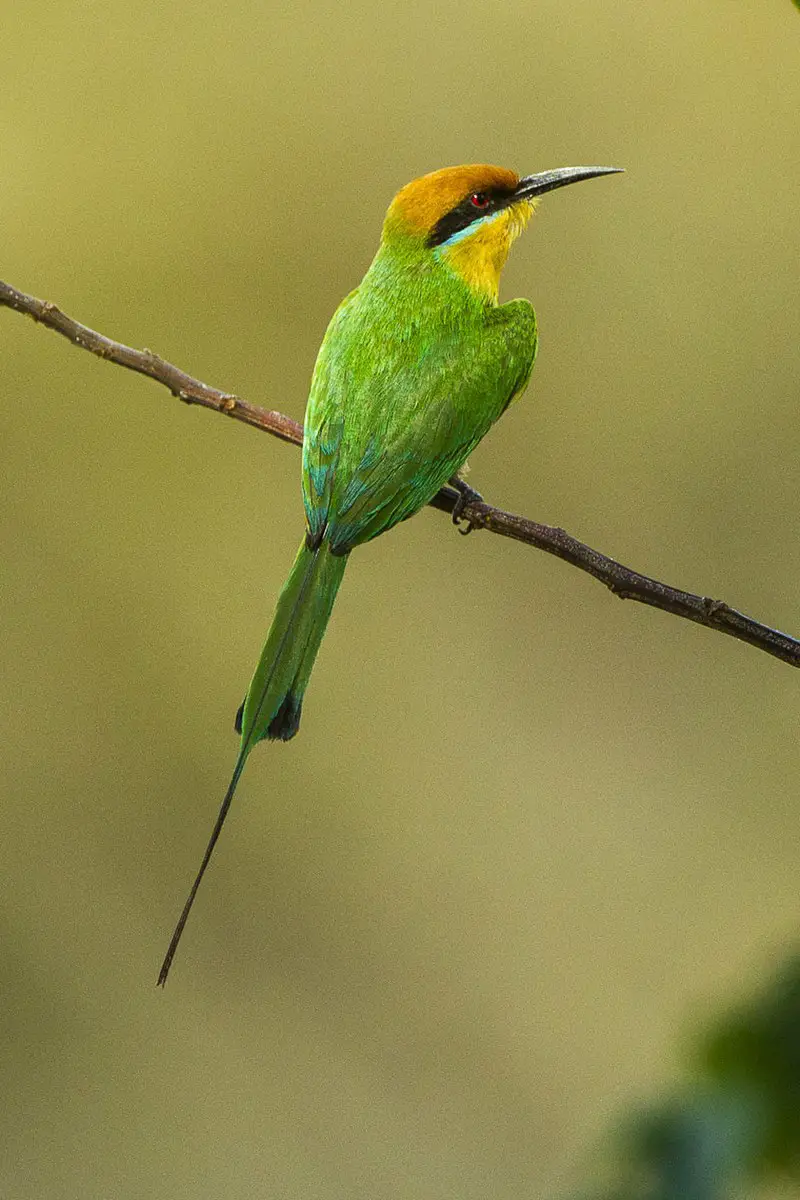
Böhm’s bee-eater is a type of bird found in the Democratic Republic of Congo, Malawi, Mozambique, Tanzania and Zambia. It belongs to the Meropidae family and was named after German zoologist Richard Böhm as a tribute for his scientific work.
These birds have bright plumage consisting mainly of shades of green with some black spots over their body and wings.
They build nests on banks near waterbodies such as rivers or lakes where they feed themselves by catching bees midair. Furthermore, these birds are also known to eat other insects like dragonflies, butterflies etc.
Moreover due to habitat loss caused by human activities there has been an alarming decline in the population size making them vulnerable according to IUCN red list assessment criteria.
Thus it becomes even more important that we take steps towards protecting this species from extinction.
Scientific classification:
| Kingdom | Animalia |
| Phylum | Chordata |
| Class | Aves |
| Order | Coraciiformes |
| Family | Meropidae |
| Genus | Merops |
| Species | M. boehmi |
3. Livingstone’s Flycatcher
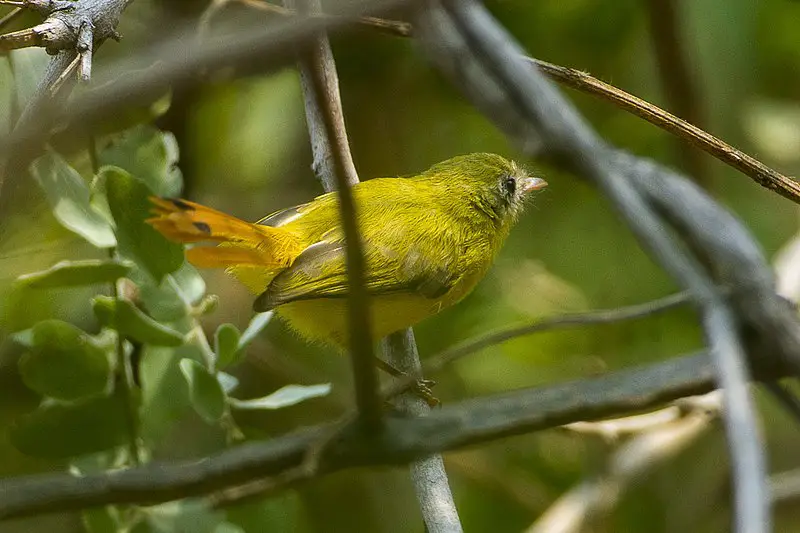
Livingstone’s flycatcher is a species of bird in the family Erythrocercidae. It lives primarily in dry forests and moist shrublands throughout Malawi, Mozambique, Tanzania, Zambia, and Zimbabwe.
These birds have mainly dark brown-grey plumage with white patches on their wings as well as pale blue or yellowish eyes and beaks that can vary from black to grey.
They are usually seen foraging alone or pairs during the day among trees looking out for food such as insects which they catch midair using their swift flight capabilities.
Livingstone’s Flycatchers also breed between September to May each year where they build nests made up of twigs near low shrubs close to water sources like rivers or streams so they can access fresh water easily when needed.
Scientific classification:
| Kingdom | Animalia |
| Phylum | Chordata |
| Class | Aves |
| Order | Passeriformes |
| Family | Erythrocercidae |
| Genus | Erythrocercus |
| Species | E. livingstonei |
4. Pied Kingfisher
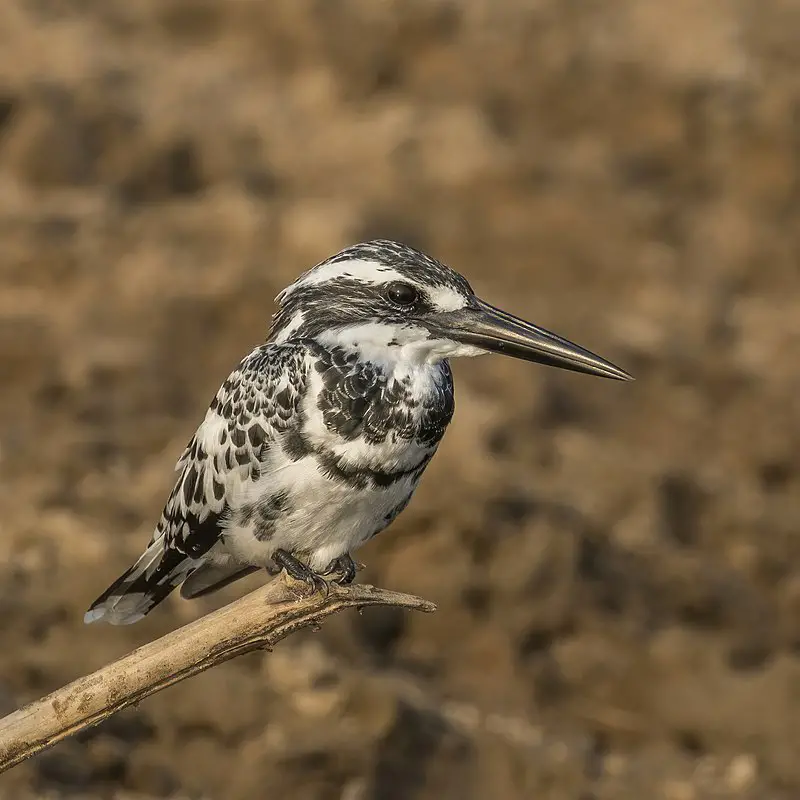
The Pied Kingfisher is a species of water kingfisher found in Africa and Asia. It has black and white plumage, with males sporting a double band across the breast while females have one single band.
This bird makes its presence known by hovering over clear waters before diving for fish – making it easily recognizable.
The diet consists mostly of small aquatic animals such as frogs, crustaceans and insects, but they also consume some plant matter like seeds or fruits occasionally.
The pied kingfisher nests near bodies of water where it can feed off smaller creatures that dwell there; usually in burrows dug into riverbanks or on floating vegetation close to shorelines.
With their distinct colors and behavior patterns these birds make an interesting addition to any wildlife enthusiast’s list.
Scientific classification:
| Kingdom | Animalia |
| Phylum | Chordata |
| Class | Aves |
| Order | Coraciiformes |
| Family | Alcedinidae |
| Subfamily | Cerylinae |
| Genus | Ceryle F. Boie, 1828 |
| Species | C. rudis |
5. Turaco
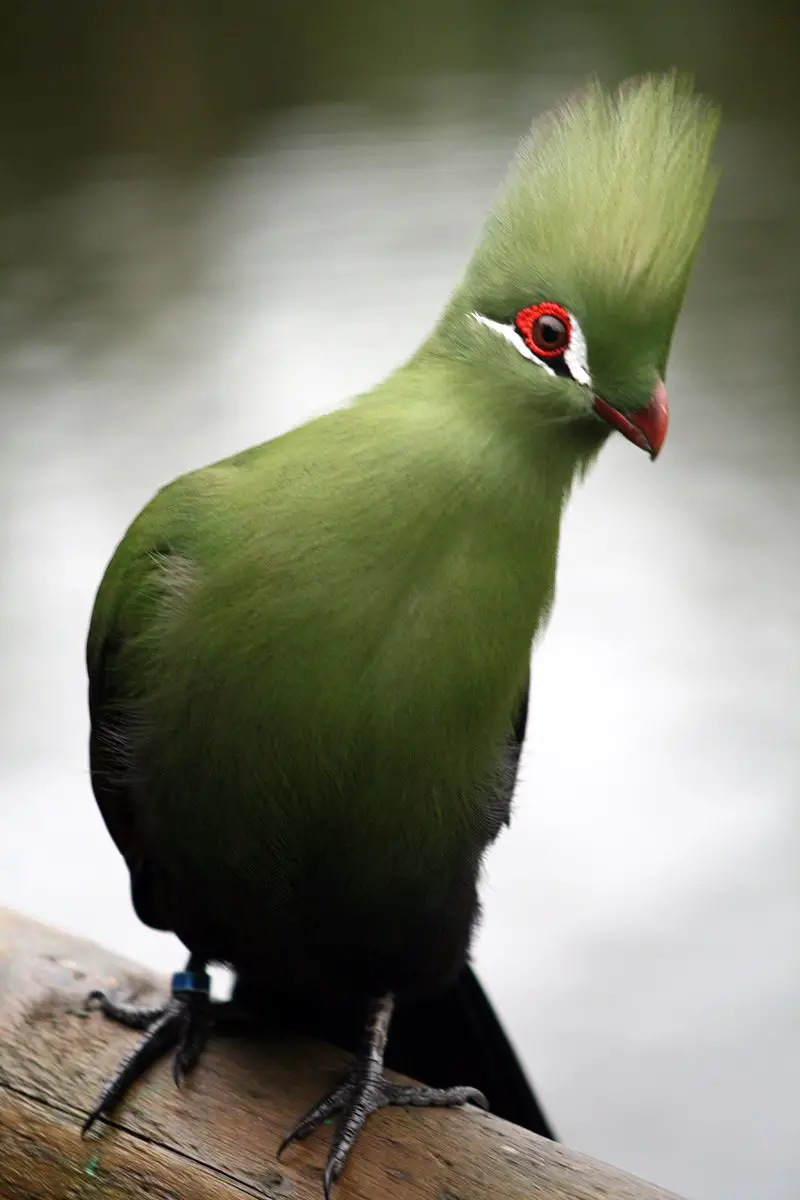
Turacos are a unique bird family that inhabit tropical and subtropical regions of Africa. They are also known as “banana-eaters” or “loeries” in southern Africa, due to their diet which consists mostly of fruit such as plantains.
These birds have an interesting semi-zygodactylous foot structure – the fourth toe can be switched back and forth while the second and third toes remain conjoined.
Turacos come in different sizes depending on species but they all generally boast bright colors like green, blue, purple or red feathers with vibrant yellow eyes.
In addition to being beautiful creatures, these birds make loud calls during mating season which makes them even more special.
Scientific classification:
| Kingdom | Animalia |
| Phylum | Chordata |
| Class | Aves |
| Clade | Otidimorphae |
| Order | Musophagiformes Seebohm, 1890 |
| Family | Musophagidae Lesson, 1828 |
6. Brown-Breasted Barbet
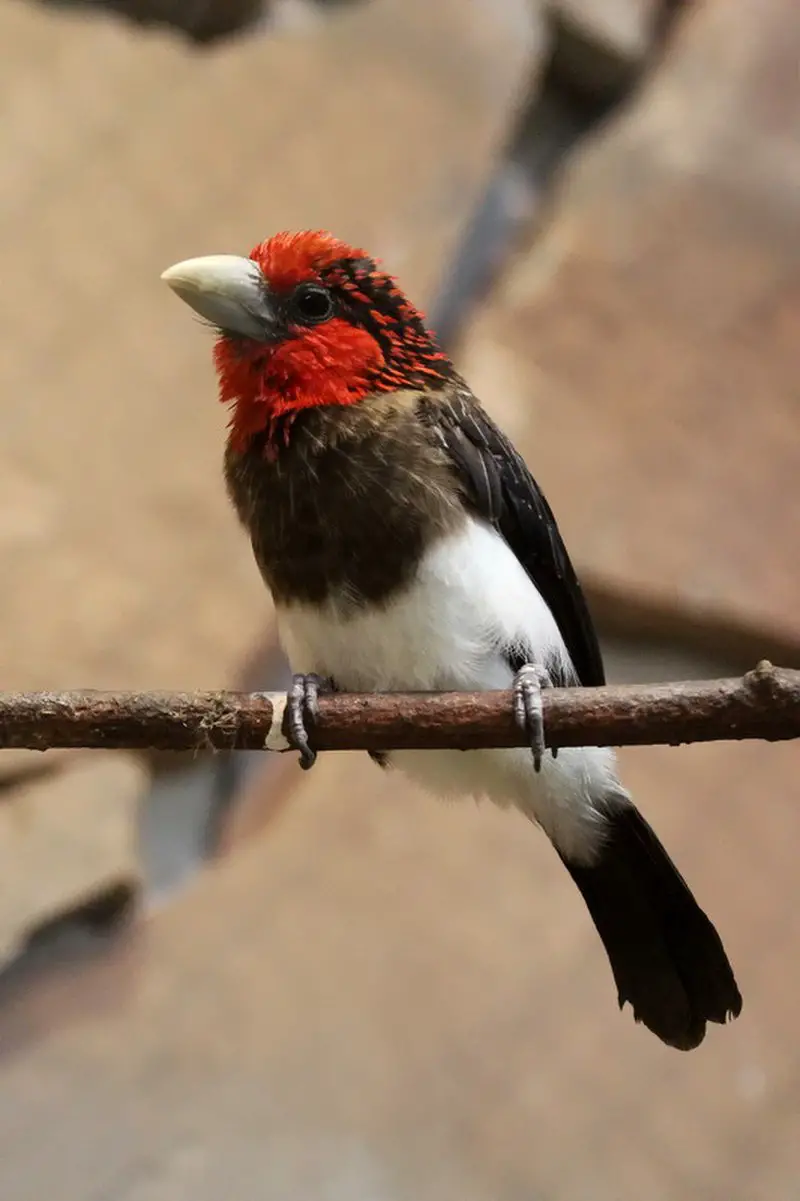
The brown-breasted barbet is a species of bird belonging to the Lybiidae family. It can be found in East Africa, inhabiting Kenya, Malawi, Mozambique, Somalia and Tanzania.
This small bird has distinctive plumage featuring an overall reddish color with black wings and tail feathers. Its head is chestnut colored while its breast is buff orange with dark streaks on it.
Additionally this species of barbet has a yellow bill as well as white ring around their eyes making them easily recognizable in their natural habitat.
They mainly feed on fruits but also consume insects when available providing great benefits for local ecosystems by dispersing seeds from fruit they eat throughout the area which helps promote biodiversity among flora and fauna alike.
Scientific classification:
| Kingdom | Animalia |
| Phylum | Chordata |
| Class | Aves |
| Order | Piciformes |
| Family | Lybiidae |
| Genus | Lybius |
| Species | L. melanopterus |
7. Livingstone’s Turaco
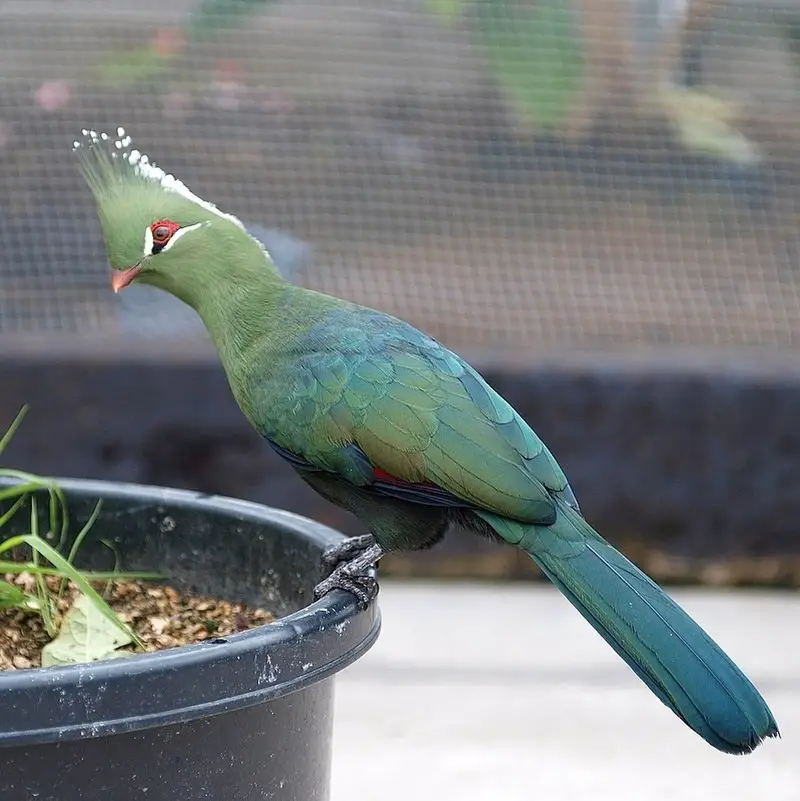
Livingstone’s turaco is a stunning and unique bird native to southeastern Africa. It was named in honor of Charles Livingstone, the brother of explorer David Livingstone.
This species can be found from Tanzania through Malawi, Zimbabwe, Mozambique and Burundi. The turaco has an unmistakeable appearance with its bright green feathers on wings and tail contrasted by red underparts that are speckled with blue-green spots.
Its bill is yellowish while its legs are dark grey or blackish in coloration. They prefer subtropical lowland forests but have been known to inhabit dry woodland areas as well where they often forage at ground level for insects like caterpillars or beetles along with fruit pulp and flowers buds from trees such as figs or mangoes which make up their diet.
Scientific classification:
| Kingdom | Animalia |
| Phylum | Chordata |
| Class | Aves |
| Order | Musophagiformes |
| Family | Musophagidae |
| Genus | Tauraco |
| Species | T. livingstonii |
8. Village Weaver
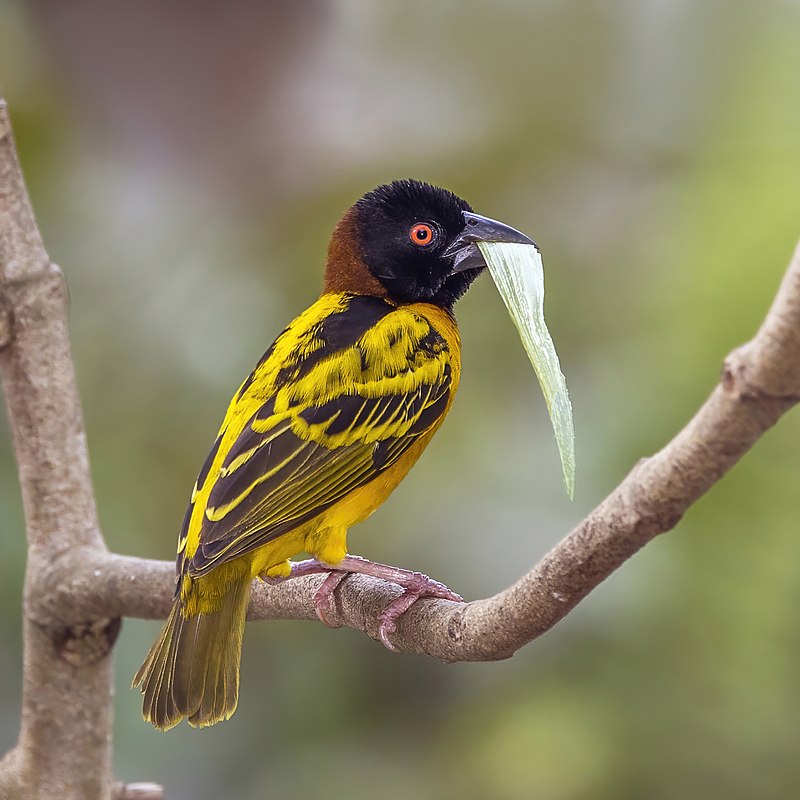
The Village Weaver is a bird found in sub-Saharan Africa, as well as on islands like Hispaniola and Martinique.
It has distinctive black heads with white spots on its back and wings.
They feed mainly on seeds but also eat some insects. The males build nests made of grasses that hang from branches or trees to attract mates during breeding season.
These birds are social creatures often seen in pairs or small groups foraging together in the same area.
Their calls are melodious chirps which can be heard throughout their range when they communicate danger or alert each other of food sources nearby.
Scientific classification:
| Kingdom | Animalia |
| Phylum | Chordata |
| Class | Aves |
| Order | Passeriformes |
| Family | Ploceidae |
| Genus | Ploceus |
| Species | P. cucullatus |
Also Featured In: Martinique Island Birds You Should Know,
9. African Cuckoo-Hawk
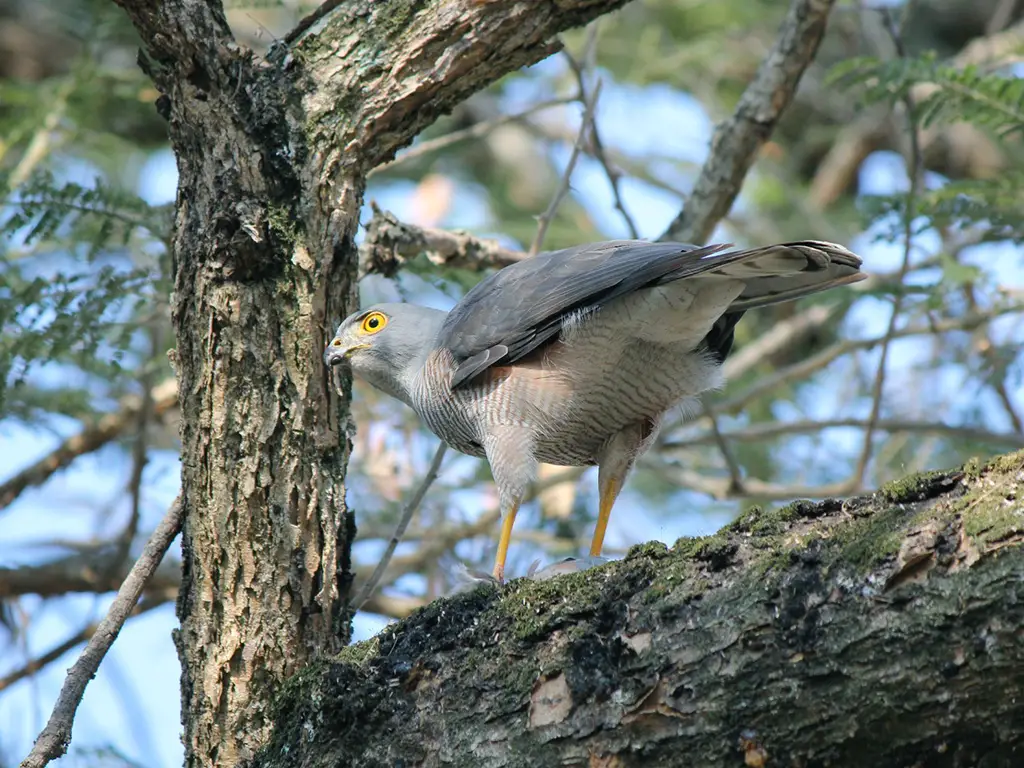
The African cuckoo-hawk is a medium sized raptor found in sub-Saharan Africa and parts of Southern Africa. It has an appearance similar to the common cuckoo, hence its name.
Males have blackish-brown upperparts with grey mantles and chests while females are paler brown above with lighter underparts streaked white and pale buff.
They usually inhabit dense woodland or forested areas where they feed mainly on insects such as moths, butterflies, dragonflies and grasshoppers which they catch by flying low over vegetation or perching in trees before swooping down for their prey.
African Cuckoohawks make loud vocalisations during breeding season when males call from treetops; these calls can be heard up to 1km away.
Scientific classification:
| Kingdom | Animalia |
| Phylum | Chordata |
| Class | Aves |
| Order | Accipitriformes |
| Family | Accipitridae |
| Genus | Aviceda |
| Species | A. cuculoides |
10. Dickinson’s Kestrel
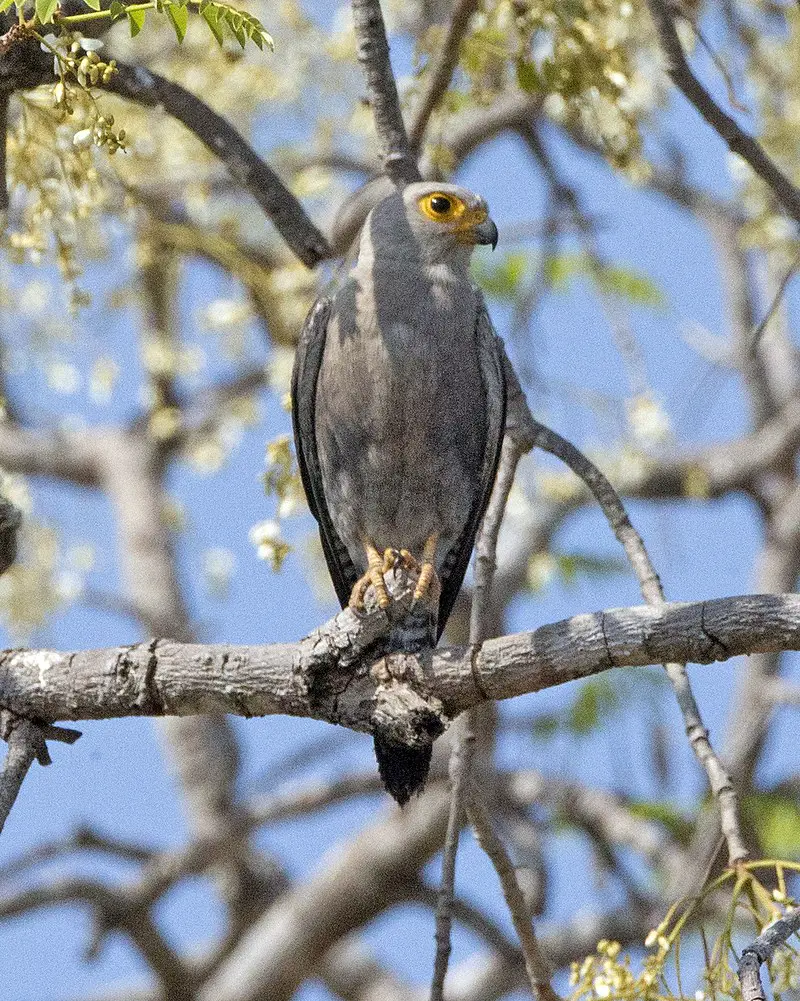
The Dickinson’s kestrel is a small, handsome falcon found in southern and eastern Africa. It has white plumage on the upperparts with black barring, rusty-red wings and tail feathers, and a distinctive white rump that gives it its alternate name of White-rumped Kestrel.
The head is pale grey while the underparts are streaked orange-brown. Its diet consists mainly of insects like grasshoppers but they will also take birds up to thrush size as well as reptiles or rodents when available.
They usually hunt from perches overlooking open areas such as savannas but can be seen hovering over fields hunting for prey too.
Though their population numbers remain stable now due to conservation efforts after being declared endangered in 2001 by BirdLife International, these beautiful raptors still face threats from habitat destruction and human disturbance so we must continue to protect them where possible.
Scientific classification:
| Kingdom | Animalia |
| Phylum | Chordata |
| Class | Aves |
| Order | Falconiformes |
| Family | Falconidae |
| Genus | Falco |
| Species | F. dickinsoni |
11. Black-Throated Wattle-Eye
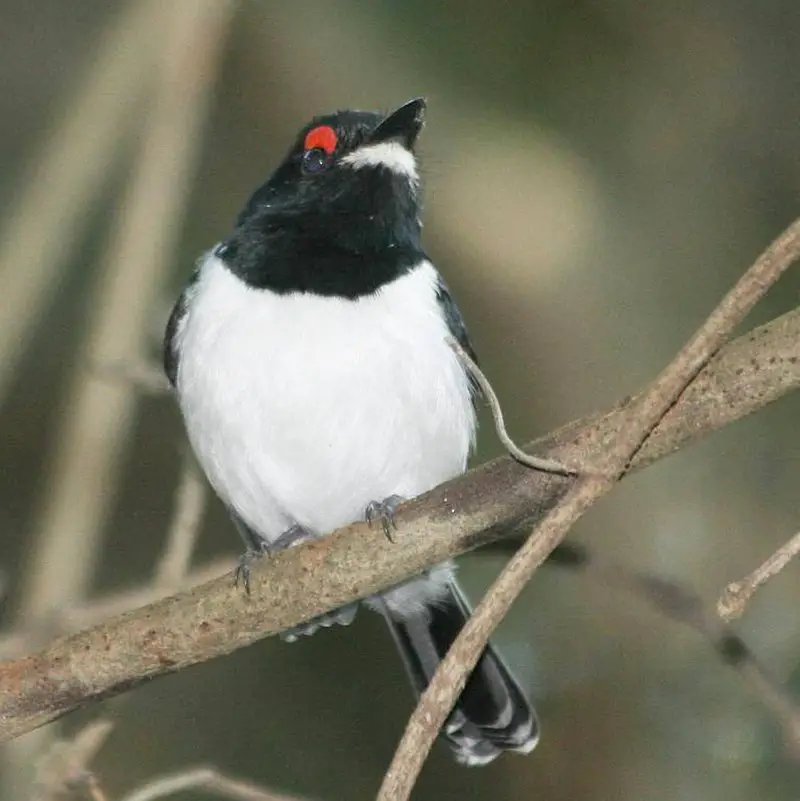
The Black-throated Wattle-eye is a species of bird belonging to the family Platysteiridae. It is found across Africa, in countries such as Angola, Burundi, Democratic Republic of Congo and Tanzania.
This small bird has an olive green back with yellowish underparts that contrast against its black throat patch. The head also features a narrow white stripe above each eye which gives it its distinctive appearance.
Its diet consists mainly of insects but can vary depending on the region or season it inhabits; some habitats may include fruit or even flowers from certain shrubs and trees.
Despite being quite common throughout much of their range they are still considered vulnerable due to deforestation and habitat loss along with hunting for food by local people in some areas.
Scientific classification:
| Kingdom | Animalia |
| Phylum | Chordata |
| Class | Aves |
| Order | Passeriformes |
| Family | Platysteiridae |
| Genus | Platysteira |
| Species | P. peltata |
12. Mousebird
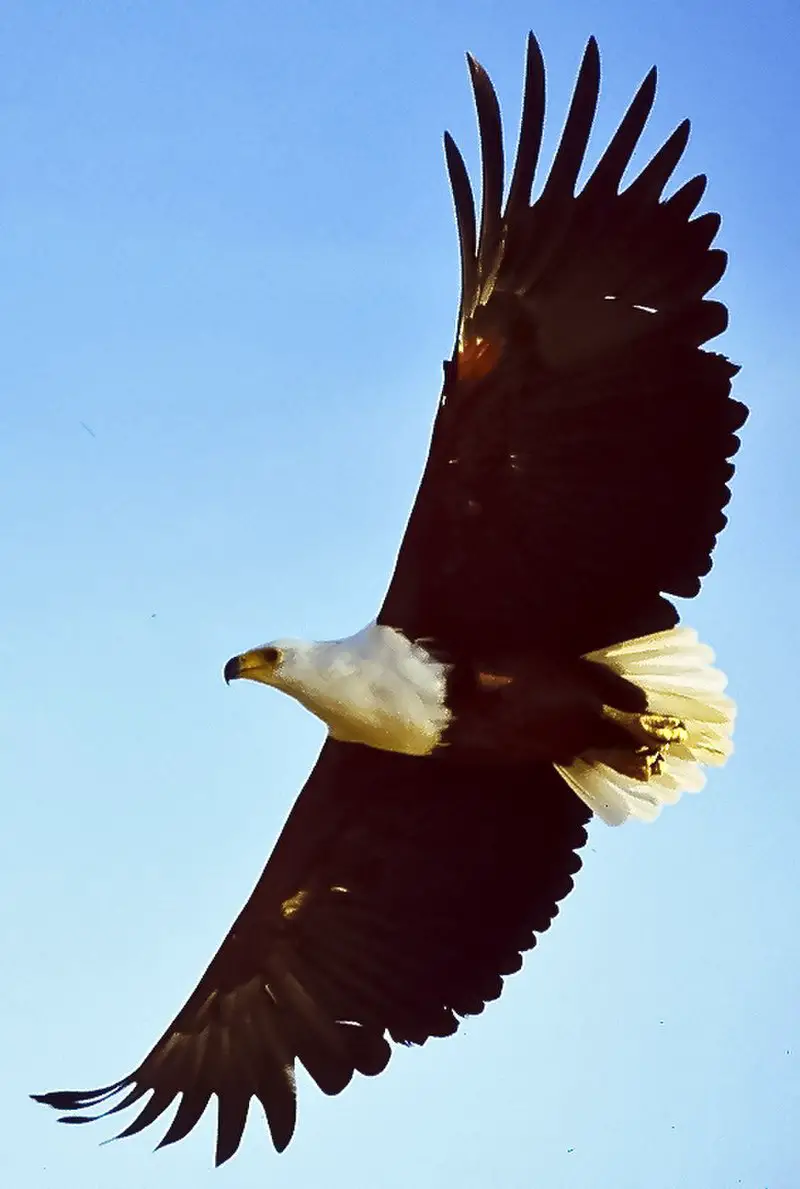
The Mousebird is a small, slender bird that can be found in parts of Africa. It has long legs and tail feathers which give it an elegant appearance. Its head is black with white streaky markings on the sides and its back is greyish-brown or brownish-grey depending on the species.
The wings are dark blue to almost purple in coloration, while the undersides of their wings are lighter colored.
They have a unique flight pattern where they flutter from tree to tree instead of flying in straight lines like other birds do. Their diet consists mainly of fruits and insects but they also eat buds, flowers, leaves, eggs and even small reptiles.
These inquisitive little birds make for interesting watching as they hop around looking for food.
13. Pel’s Fishing Owl
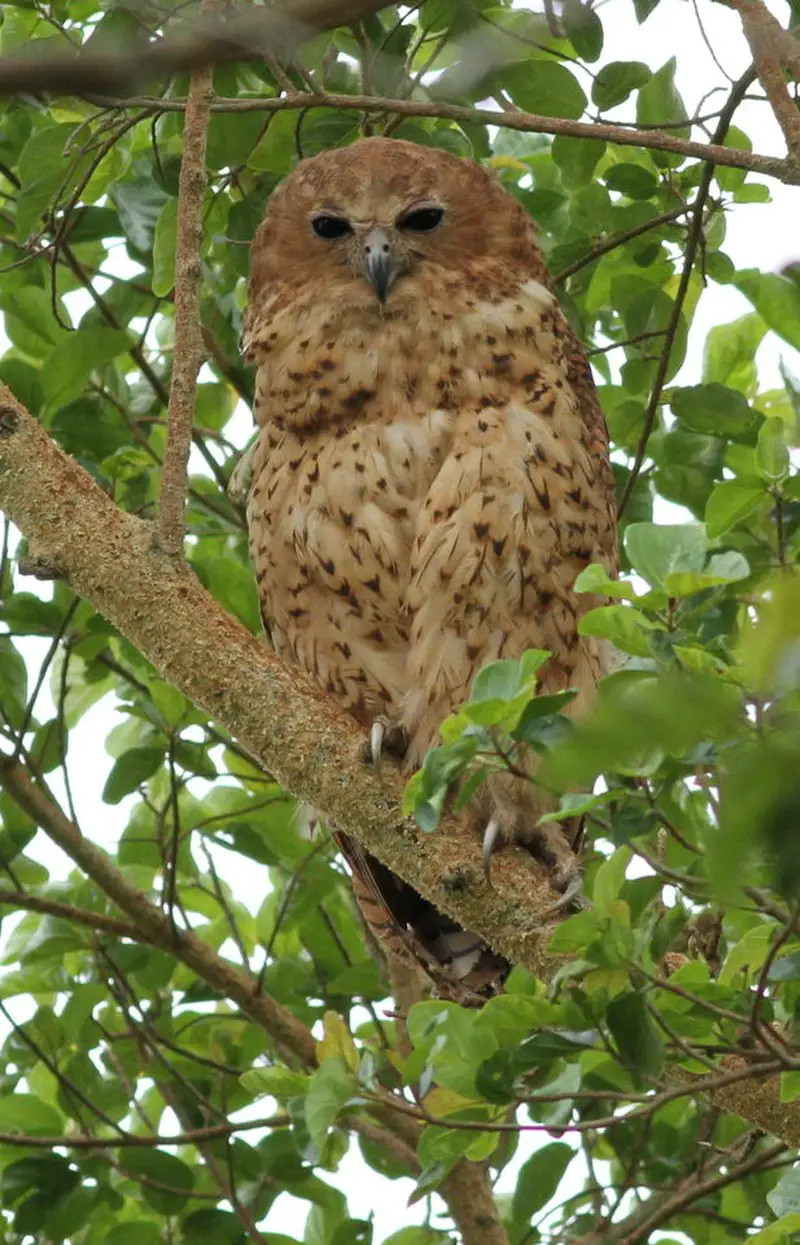
Pel’s fishing owl is a large species of Strigidae found in Africa. It hunts mainly at night, snatching up fish and frogs from rivers and lakes with its sharp talons.
They prefer slow-moving waterways with lots of overhanging trees so they can roost during the day or hunt for prey without being seen.
The owls nest in hollows or forks of large trees to stay safe from predators.
Even though there are many threats that put these birds at risk, conservation efforts have helped secure their population numbers for now.
Scientific classification:
| Kingdom | Animalia |
| Phylum | Chordata |
| Class | Aves |
| Order | Strigiformes |
| Family | Strigidae |
| Genus | Scotopelia |
| Species | S. peli |
14. Lybiidae
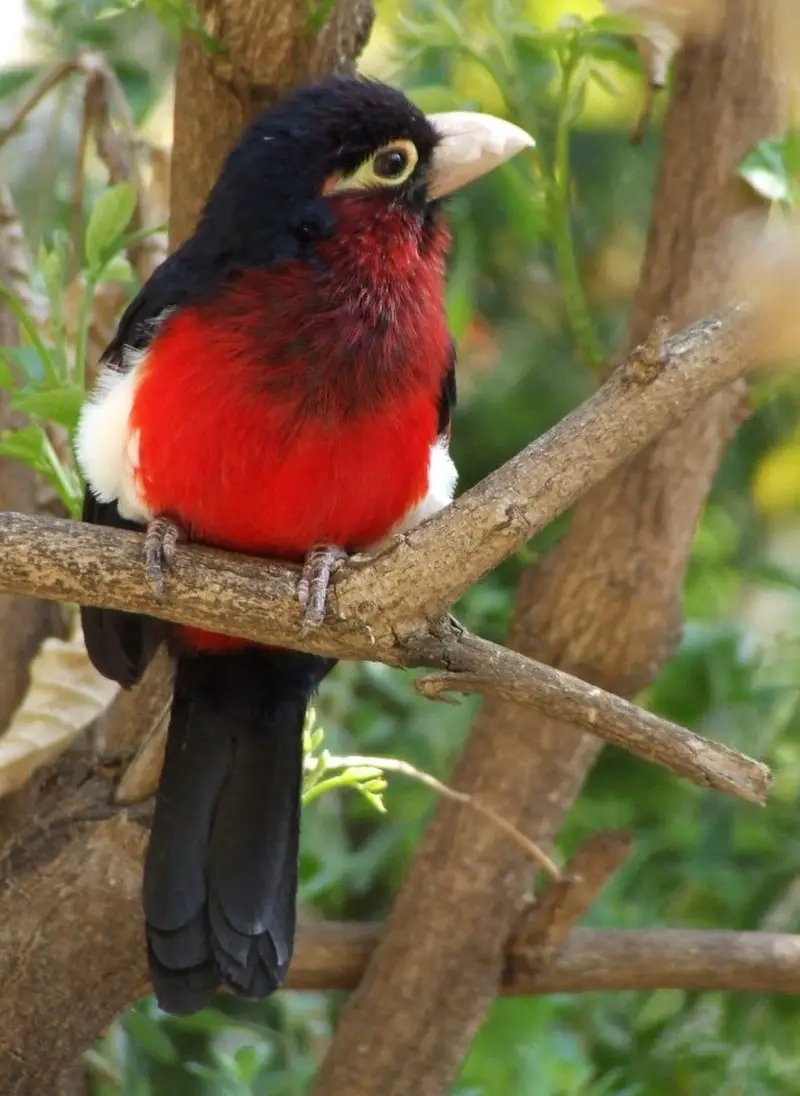
African barbets, belonging to the family Lybiidae, are a large group of birds found throughout sub-Saharan Africa.
They come in different sizes and inhabit various habitats from forests interiors to scrublands.
The Trachyphoninae species live mainly in the southern Sahara desert up until South Africa.
These colourful birds have distinctive features such as their short neck and stout bill that is used for cracking open hard nuts or drilling into tree bark for food.
Some African barbet species are important pollinators of flowers due to their diet consisting mostly on fruits and nectar which forces them to visit many plants daily.
Their bright calls can be heard throughout the day making them easily recognisable by humans too.
Scientific classification:
| Kingdom | Animalia |
| Phylum | Chordata |
| Class | Aves |
| Order | Piciformes |
| Infraorder | Ramphastides |
| Family | Lybiidae Sibley & Ahlquist, 1985 |
15. Southern Ground Hornbill
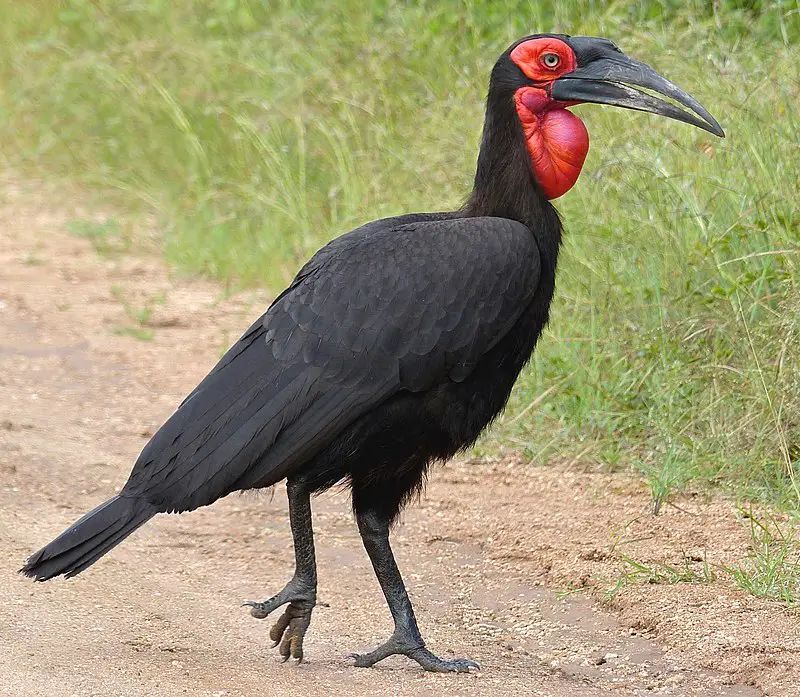
The Southern Ground Hornbill is a majestic bird, native to the southern regions of Africa such as Kenya and South Africa. It inhabits both woodlands and savannas where it can be found in abundance.
These birds are quite large, making them the largest species within their order worldwide. They have striking black feathers with red patches on their neck and wings which make for an impressive sight when taking flight.
A unique feature of these birds is that they form long-term pairs or family groups; usually consisting of two adults plus several helper offspring from previous years who assist in raising new young chicks together.
This amazing creature’s powerful presence remains unchanged throughout its range – reminding us why conservation efforts must persist if we want this incredible bird to remain part of our planet’s diverse wildlife heritage for centuries to come.
Scientific classification:
| Kingdom | Animalia |
| Phylum | Chordata |
| Class | Aves |
| Order | Bucerotiformes |
| Family | Bucorvidae |
| Genus | Bucorvus |
| Species | B. leadbeateri |
16. Bucorvus
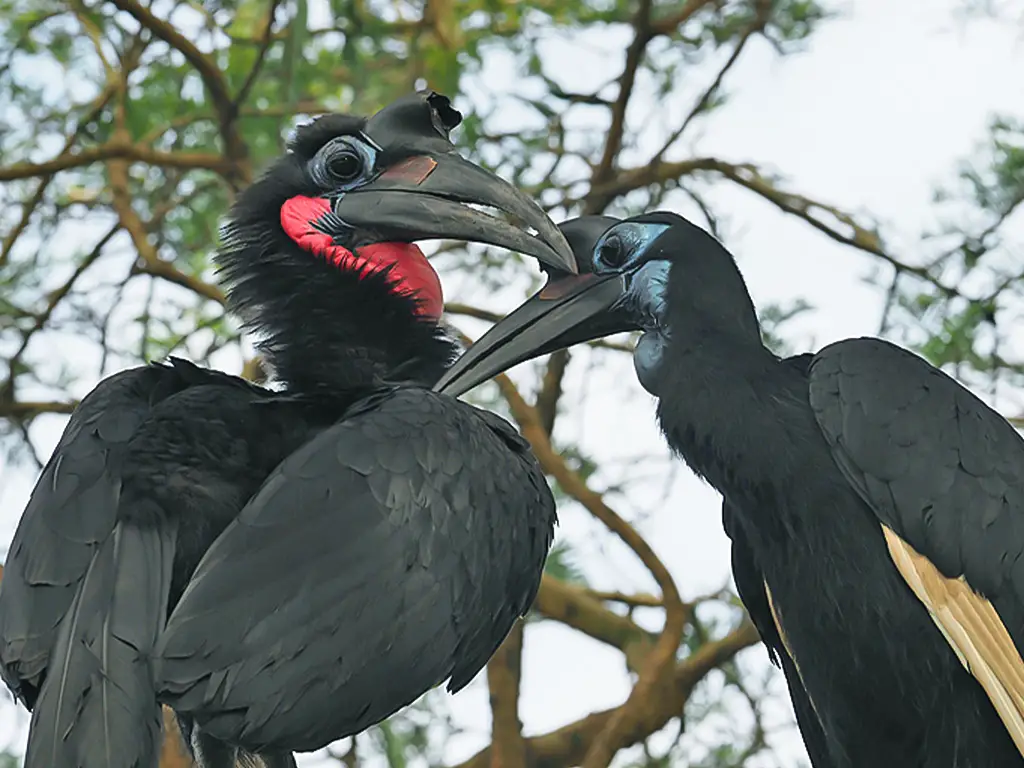
Bucorvus is a species of large bird from the family Bucorvidae, endemic to sub-Saharan Africa. They are approximately 1m tall and both species have black feathers with patches of red or purple on their wings and neck.
The Abyssinian ground hornbill occurs in a belt from Senegal east to Ethiopia while the southern ground hornbill lives in Southern and East Africa.
Ground Hornbills are omnivorous birds that feed mainly on insects, snakes, lizards, small mammals as well as fruits like figs.
They also build nests high up in trees which they line with mud for insulation before laying eggs inside them.
Their legs are very long allowing them to walk over distances looking for food sources easily compared to other avian species.
Scientific classification:
| Kingdom | Animalia |
| Phylum | Chordata |
| Class | Aves |
| Order | Bucerotiformes |
| Family | Bucorvidae Bonaparte, 1854 |
| Genus | Bucorvus Lesson, 1830 |
17. Anchieta’s Sunbird
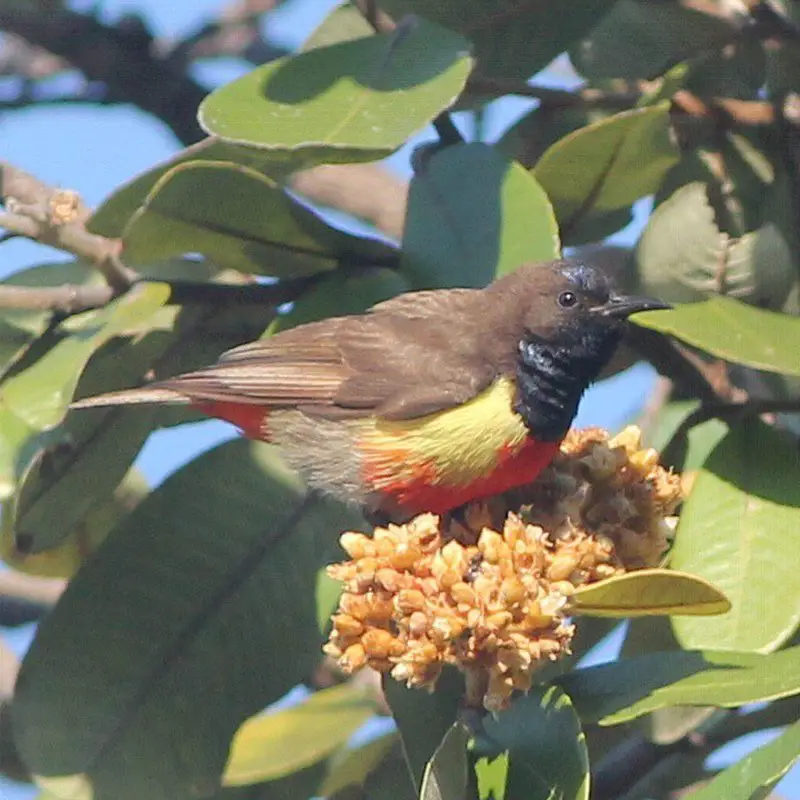
Anchieta’s sunbird is a beautiful species of bird from the family Nectariniidae found in several parts of Africa. It has an iridescent plumage, with green and golden feathers on its upperparts and yellowish-green ones below.
Its head is grey while its throat is bright yellow. This species was named after José Alberto de Oliveira Anchieta, who studied birds in Angola during the 19th century. The diet of this small songbird consists mostly of nectar taken from flowers, as well as some insects to supplement it nutritionally.
They are solitary feeders but may form flocks when looking for food or sheltering during harsh weather conditions like heavy rains or strong winds.
These tiny birds can be seen perched atop trees searching for food or singing their melodious songs – usually early in the morning – which makes them a delight to watch.
Scientific classification:
| Kingdom | Animalia |
| Phylum | Chordata |
| Class | Aves |
| Order | Passeriformes |
| Family | Nectariniidae |
| Genus | Anthreptes |
| Species | A. anchietae |
18. Little Bee-Eater
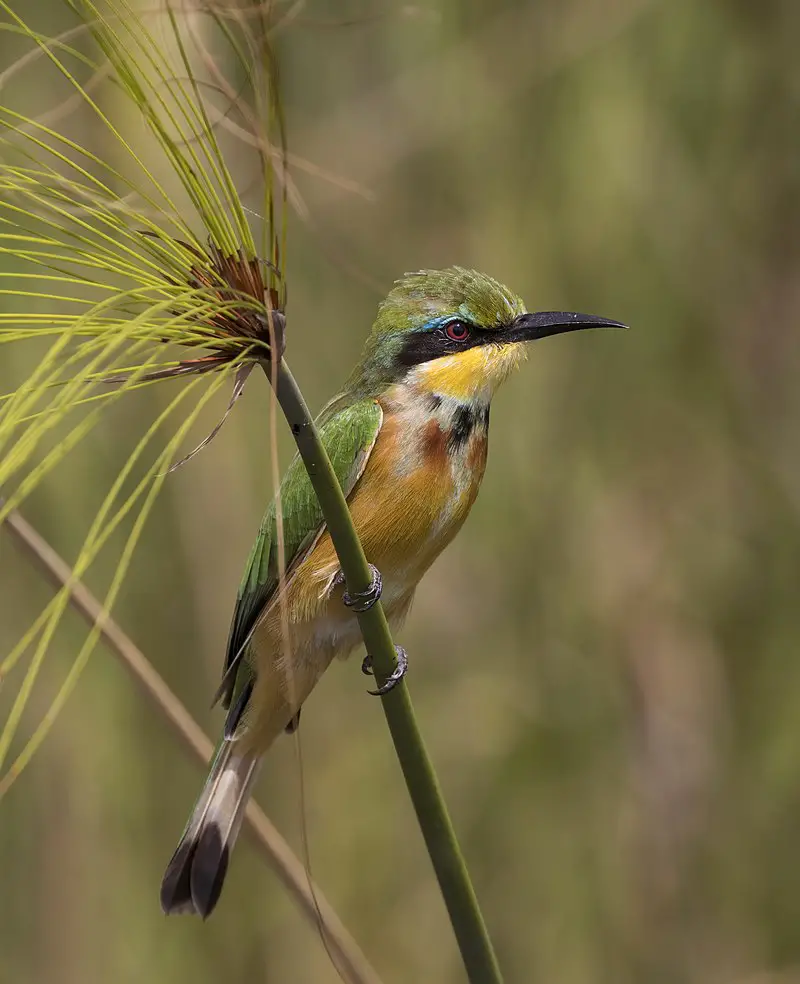
The Little Bee-eater (Merops pusillus) is a beautiful species of bird belonging to the family Meropidae.
These birds are found in much of Sub-Saharan Africa and their migration patterns depend on seasonal rainfall changes.
They have slender, brightly coloured bodies with an iridescent green sheen across the wings and back.
Their diet consists mainly of bees, wasps, dragonflies, moths and other insects which they catch mid-air or from perches above open grasslands or along mudbanks near water sources like rivers and lakes.
In order for these birds to digest their food properly before swallowing it whole, they use pebbles that help them grind up hard exoskeletons so as not to cause any blockages within their digestive tract – something only bee-eaters do.
Scientific classification:
| Kingdom | Animalia |
| Phylum | Chordata |
| Class | Aves |
| Order | Coraciiformes |
| Family | Meropidae |
| Genus | Merops |
| Species | M. pusillus |
Also Featured In: African Birds, Savanna Birds You Need to See
19. African Hawk-Eagle
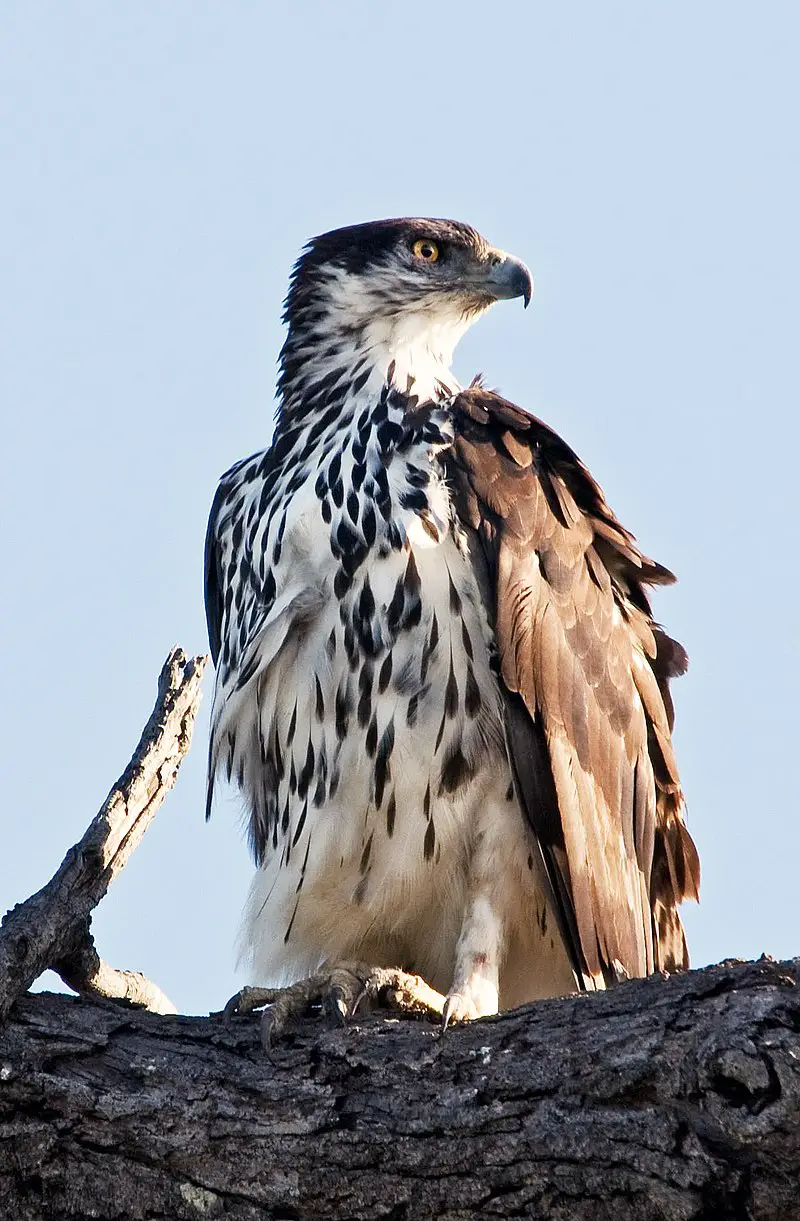
The African hawk-eagle is a majestic bird of prey belonging to the Accipitridae family. It inhabits tropical regions of Sub-Saharan Africa, and prefers dry woodlands or savannas for its habitat.
This species stands out due to its feathered legs – an adaptation which sets it apart from other members in the Aquilinae subfamily.
The eagle shows great agility while hunting with swift aerial dives, and can be seen perched atop tall trees as part of their hunting strategy.
With strong talons and sharp curved beaks they feed on small reptiles, mammals or birds such as doves and quail – making them apex predators within their ecosystem.
Scientific classification:
| Kingdom | Animalia |
| Phylum | Chordata |
| Class | Aves |
| Order | Accipitriformes |
| Family | Accipitridae |
| Genus | Aquila |
| Species | A. spilogaster |
Also Featured In: Birds that You’ll Find in Kruger national park,
20. Pearl-Spotted Owlet
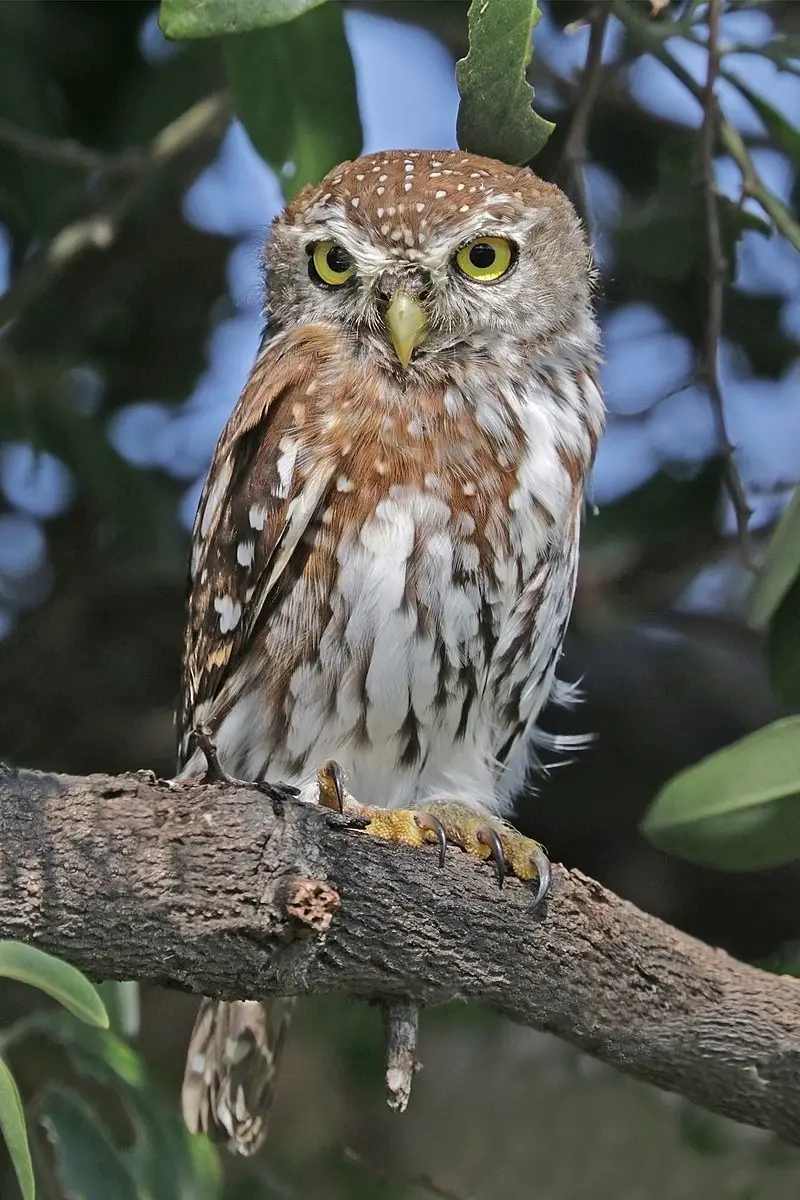
The Pearl-spotted Owlet is a small bird of prey that lives in sub-Saharan Africa. It belongs to the Strigidae family, which are commonly referred to as typical owls or true owls.
These birds have brown feathers with heavy spots, making them easily recognizable among other species of owl.
They usually measure between 14 and 16 centimeters long with an average wingspan of 28 centimeters wide.
Their diet consists mainly of insects such as moths and beetles but they also feed on frogs and small rodents occasionally.
During mating season males will use their sharp call for territorial purposes while females remain silent during this time period.
The female lays 2-4 eggs at one time before incubating them for around 3 weeks until hatching occurs after which both parents take part in feeding their young chicks until fledging age which is when they become independent enough to survive on their own in nature.
Scientific classification:
| Kingdom | Animalia |
| Phylum | Chordata |
| Class | Aves |
| Order | Strigiformes |
| Family | Strigidae |
| Genus | Glaucidium |
| Species | G. perlatum |
21. African Grey Hornbill
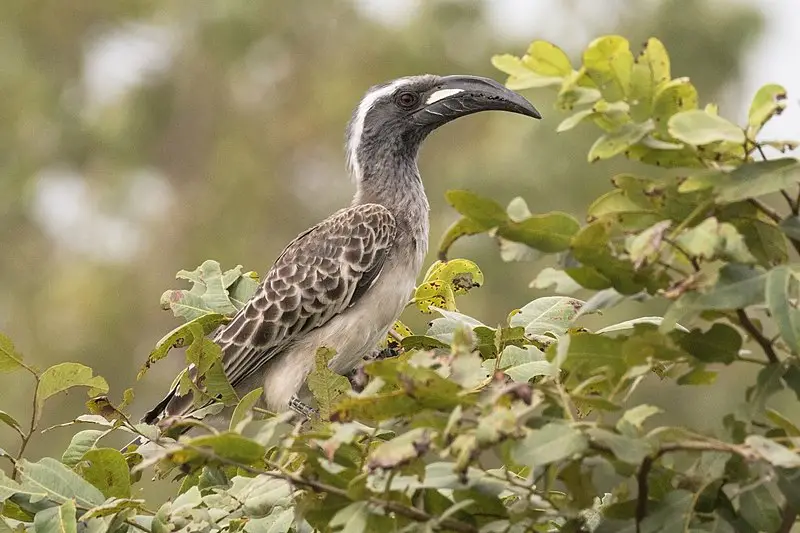
The African grey hornbill is a large bird with striking black and white plumage. Its most recognizable feature is its long, down-curved bill which has a red base and yellow tip.
They are found in sub-Saharan Africa as well as Arabia and have been known to escape or be released into Florida where they may not be breeding yet.
Their diet mainly consists of fruits, insects, small reptiles and amphibians making them important seed dispersers for their habitats.
Hornbills play an important role in the ecosystem by controlling pests like locusts while also providing food for predators such as eagles or larger cats.
These birds are often kept as pets but can become very demanding due to their intelligence so potential owners should do research before considering one of these amazing creatures.
Scientific classification:
| Kingdom | Animalia |
| Phylum | Chordata |
| Class | Aves |
| Order | Bucerotiformes |
| Family | Bucerotidae |
| Genus | Lophoceros |
| Species | L. nasutus |
22. Crowned Hornbill
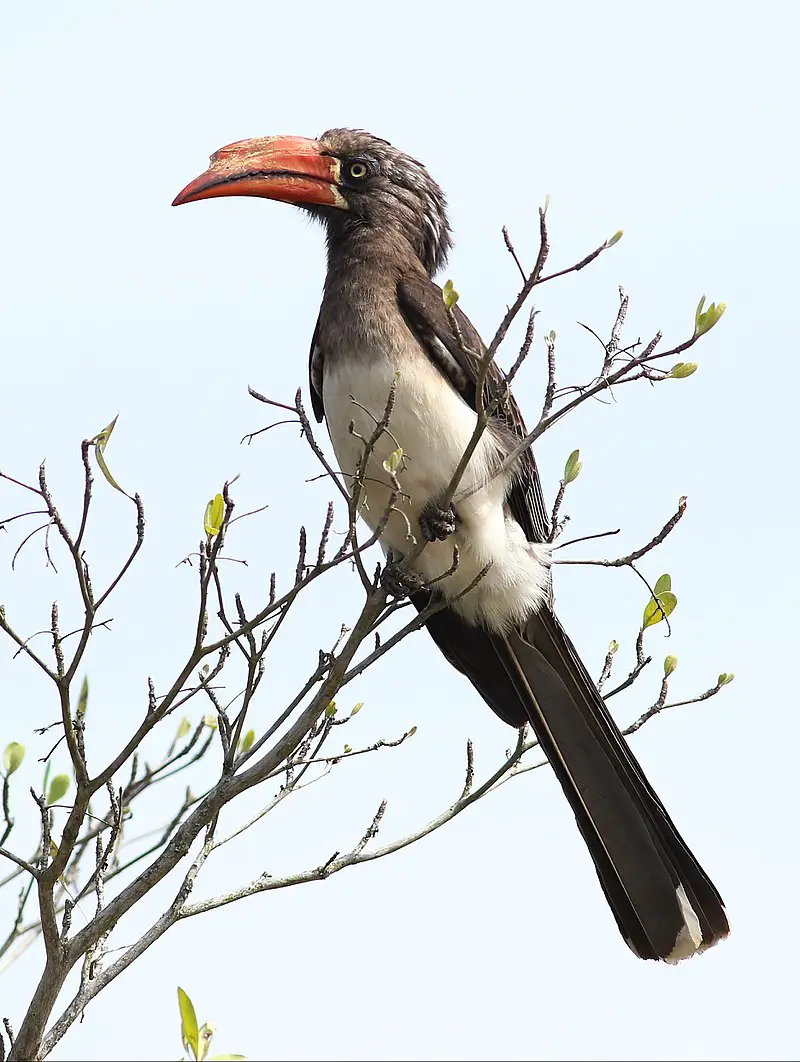
The Crowned Hornbill is a medium-sized bird found in Africa. It has yellow eyes, red beak and white belly with black back and wings. The tips of the long tail feathers are also white which makes it an attractive species to look at.
Its most distinctive feature would be its casque on top of the upper mandible that makes it stand out from other hornbills. Females have smaller casques than males, making them easily identifiable apart from each other.. They feed mainly on fruits but will occasionally eat insects as well.
These birds breed during rainy season when there’s plenty of food available for their young ones .Their nests can usually be found high up in tree cavities or termite mounds where they build mud walls around them to protect themselves against predators such as eagles or snakes while incubating eggs and raising chicks until they fledge successfully into adulthood.
Scientific classification:
| Kingdom | Animalia |
| Phylum | Chordata |
| Class | Aves |
| Order | Bucerotiformes |
| Family | Bucerotidae |
| Genus | Lophoceros |
| Species | L. alboterminatus |
23. Yellow-Fronted Tinkerbird
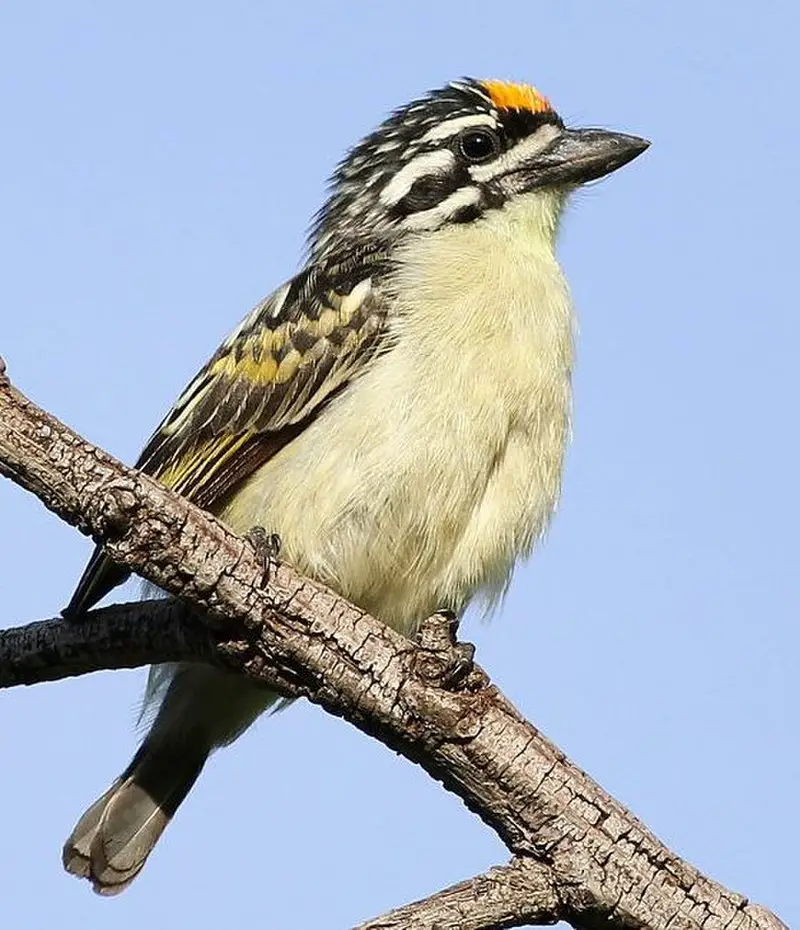
The yellow-fronted tinkerbird is a small African barbet found throughout tropical regions of the continent. It is easily recognized by its bright yellow forehead and brownish plumage, which may vary among different subspecies.
These birds feed mainly on insects and fruit; they use their stout bill to break open hard fruits while searching for food in dense vegetation.
They tend to live in pairs or family groups that occupy large territories, with males singing loudly from prominent perches during breeding season as part of territorial defense.
The population appears stable overall but some subspecies are considered threatened due to habitat destruction and fragmentation.
Scientific classification:
| Kingdom | Animalia |
| Phylum | Chordata |
| Class | Aves |
| Order | Piciformes |
| Family | Lybiidae |
| Genus | Pogoniulus |
| Species | P. chrysoconus |
Also Featured In: Birds that Live in lake Mburo National Park,
24. Tropical Boubou
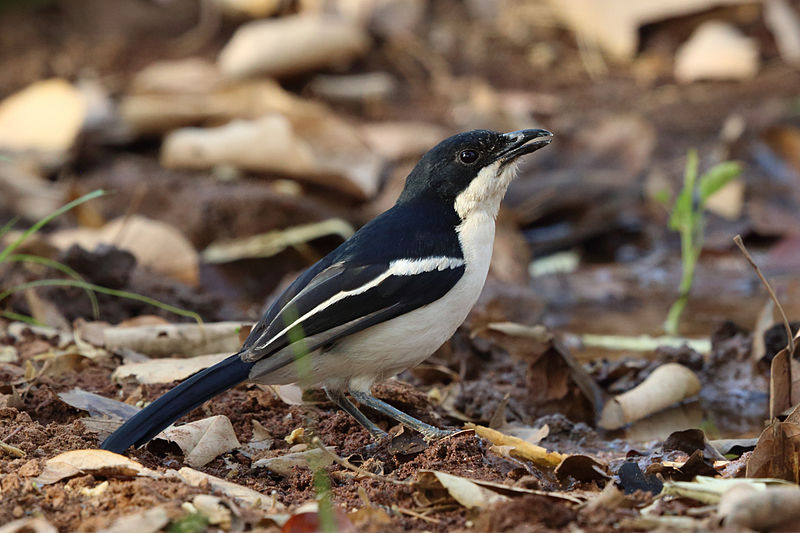
The Tropical Boubou, also known as Bell Shrike, is a medium-sized passerine bird found in sub-Saharan Africa.
It has long been considered to be a single species with numerous morphs and subspecies, however recent research suggests it actually belongs to an entire complex of different species.
They are fairly large for their family; growing up to 25 cm (10 inches) in length and weighing around 40g (1 ounce).
The males have black upper parts while the females tend to be greyish brown or olive green.
Both sexes possess white underparts with barring on the chest and wings as well as some distinctive facial patterns – one being two yellow ‘eyebrows’ over each eye.
These birds feed primarily on insects but will sometimes take fruit too.
Scientific classification:
| Kingdom | Animalia |
| Phylum | Chordata |
| Class | Aves |
| Order | Passeriformes |
| Family | Malaconotidae |
| Genus | Laniarius |
| Species | L. aethiopicus |
25. White-Browed Coucal
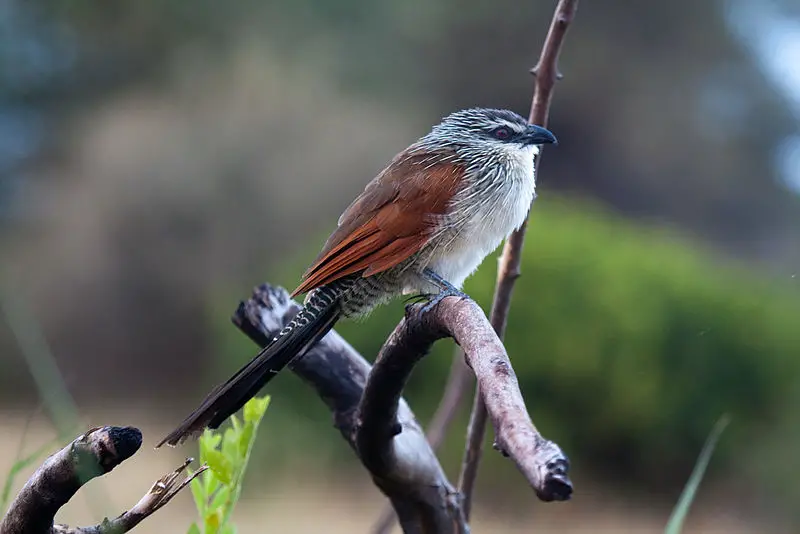
The White-browed Coucal is a species of bird belonging to the Cuculidae family. It can be found in sub-Saharan Africa, inhabiting thick vegetation and rank undergrowth as well as coastal regions.
This medium-sized cuckoo has a length between 36 and 42 cm and is sometimes considered a subspecies of Burchell’s coucal.
Its main distinguishing feature is its white eyebrow which extends towards the back of its head, giving it an elegant look that makes it stand out from other birds in its habitat.
Additionally, this species also features black plumage with some yellow spots on their wings and tail feathers for extra beauty points.
All in all, these fascinating creatures make great additions to any wildlife enthusiast’s list of spotted animals.
Scientific classification:
| Kingdom | Animalia |
| Phylum | Chordata |
| Class | Aves |
| Order | Cuculiformes |
| Family | Cuculidae |
| Genus | Centropus |
| Species | C. superciliosus |
26. Racket-Tailed Roller
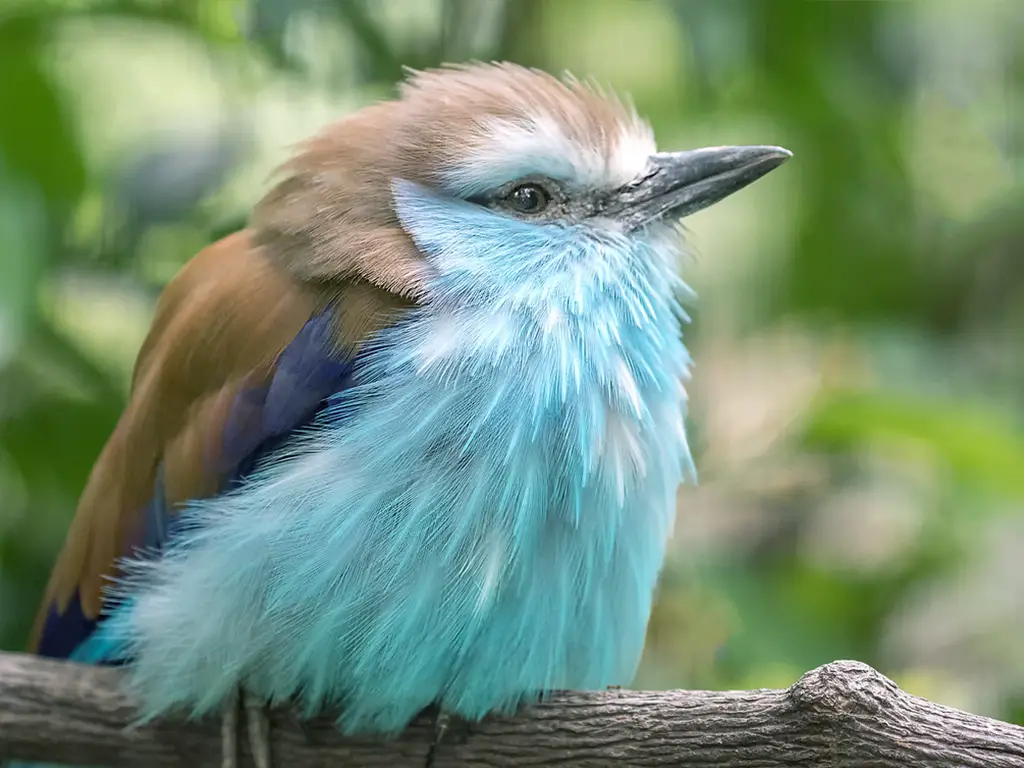
The Racket-tailed roller is a beautiful bird that can be found in Southern Africa. It belongs to the family Coraciidae and was formally described by Roland Trimen in 1880 under its current binomial name, Coracias spatulatus.
This species of bird ranges from Angola, south-eastern Democratic Republic of Congo and southern Tanzania all the way up to northern Botswana, Zimbabwe, Malawi and Mozambique.
The most distinguishing feature about this birds are their long tail feathers which have white tips at each end forming an unique “racket.”
They also have bright blue upperparts with black wings and a chestnut head along with pale yellowish breasts streaked brown or gray underneath.
These intelligent creatures feed mainly on insects such as beetles but they will also eat small fruits occasionally if available. In addition they enjoy bathing frequently during summer days making them even more fun to watch.
Scientific classification:
| Kingdom | Animalia |
| Phylum | Chordata |
| Class | Aves |
| Order | Coraciiformes |
| Family | Coraciidae |
| Genus | Coracias |
| Species | C. spatulatus |
27. Brown-Hooded Kingfisher
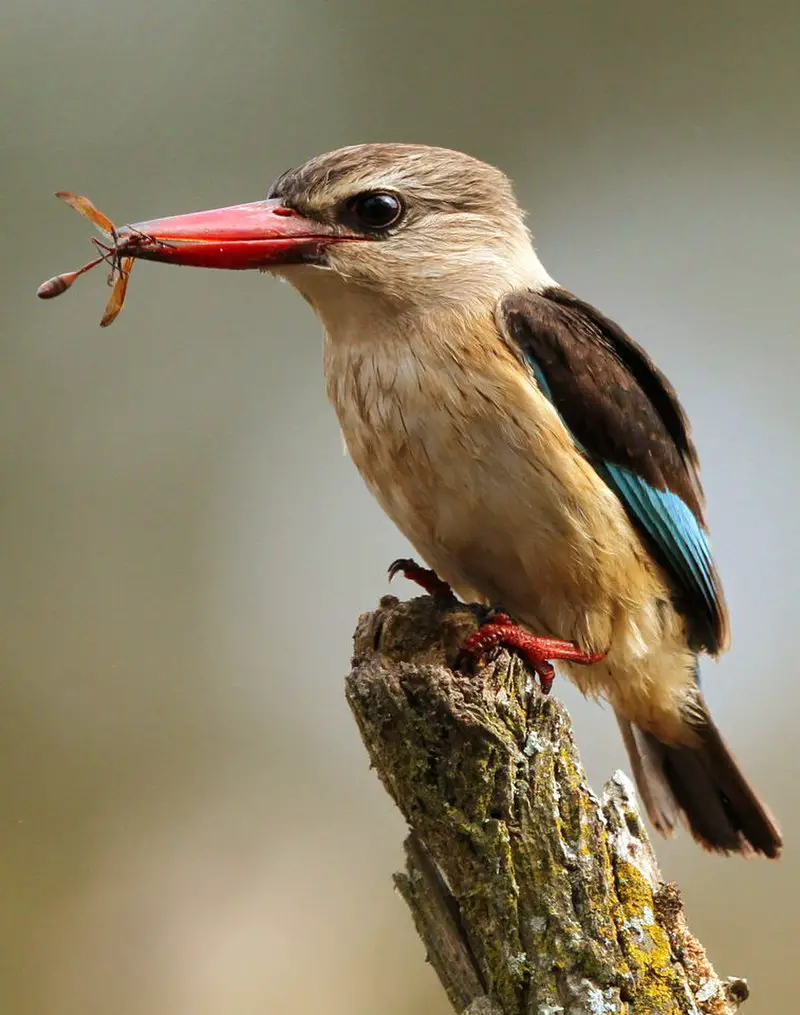
The Brown-hooded kingfisher is a species of bird found in Sub-Saharan Africa. It has a brown head and blackish, turquoise wings which makes it quite distinguishable among other types of birds.
They prefer to live near woodlands, scrubland, forest edges and even suburban areas so they can easily find food sources such as beetles, grasshoppers or small lizards that make up their diet.
The International Union for Conservation of Nature (IUCN) considers the Brown-hooded Kingfisher as being of least concern due to its wide distribution range and abundance across many regions throughout Africa.
Scientific classification:
| Kingdom | Animalia |
| Phylum | Chordata |
| Class | Aves |
| Order | Coraciiformes |
| Family | Alcedinidae |
| Subfamily | Halcyoninae |
| Genus | Halcyon |
| Species | H. albiventris |
Also Featured In: Birds of KwaZulu-Natal,
28. Western Banded Snake Eagle
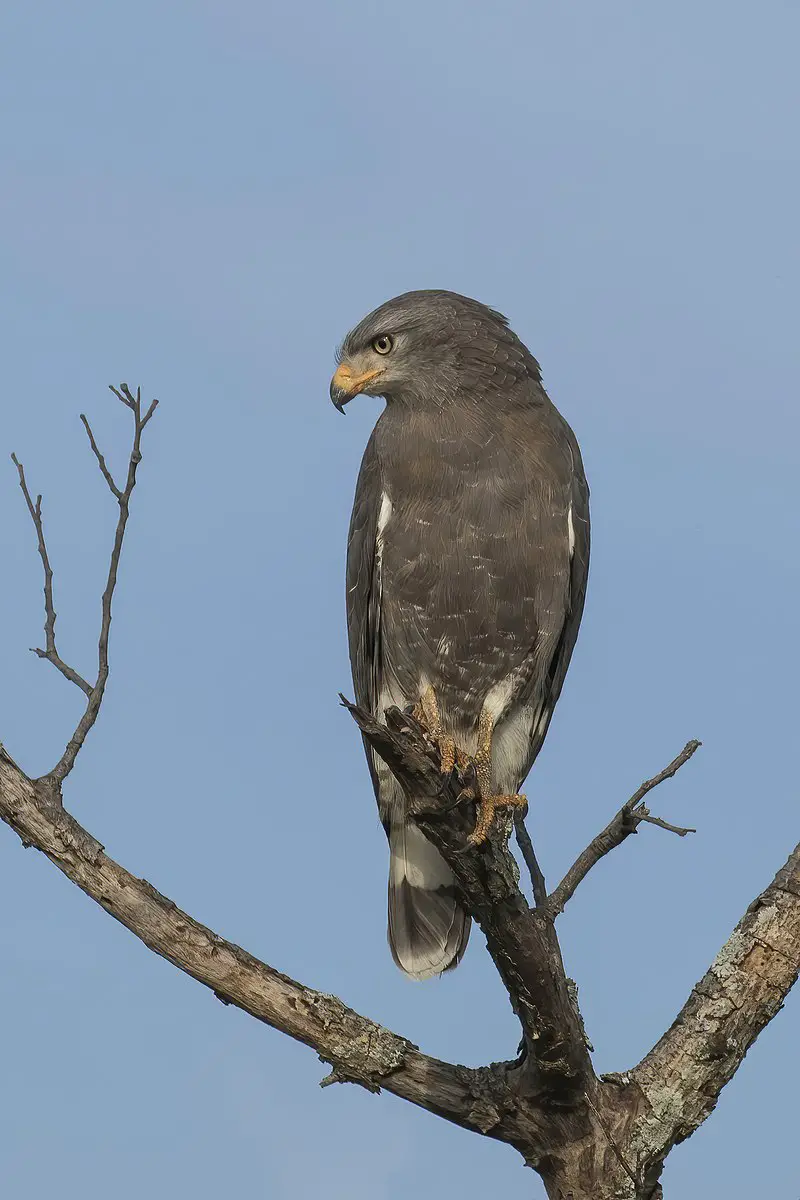
The Western banded snake eagle is a beautiful African raptor, with grey-brown upper parts and white edged feathers. Juveniles have paler and browner colors while adults develop darker hues.
Its head, neck and breast are darkly streaked, offset by its white underparts which feature pale brown streaks on the belly and thighs. Subadults may lack any streaky patterning all together.
These birds mainly live in open woodlands near rivers or lakes where they hunt snakes as well as other small animals like lizards for food. They build nests high up in trees to protect their young from predators – watchful parents indeed.
Scientific classification:
| Kingdom | Animalia |
| Phylum | Chordata |
| Class | Aves |
| Order | Accipitriformes |
| Family | Accipitridae |
| Genus | Circaetus |
| Species | C. cinerascens |
29. Trumpeter Hornbill
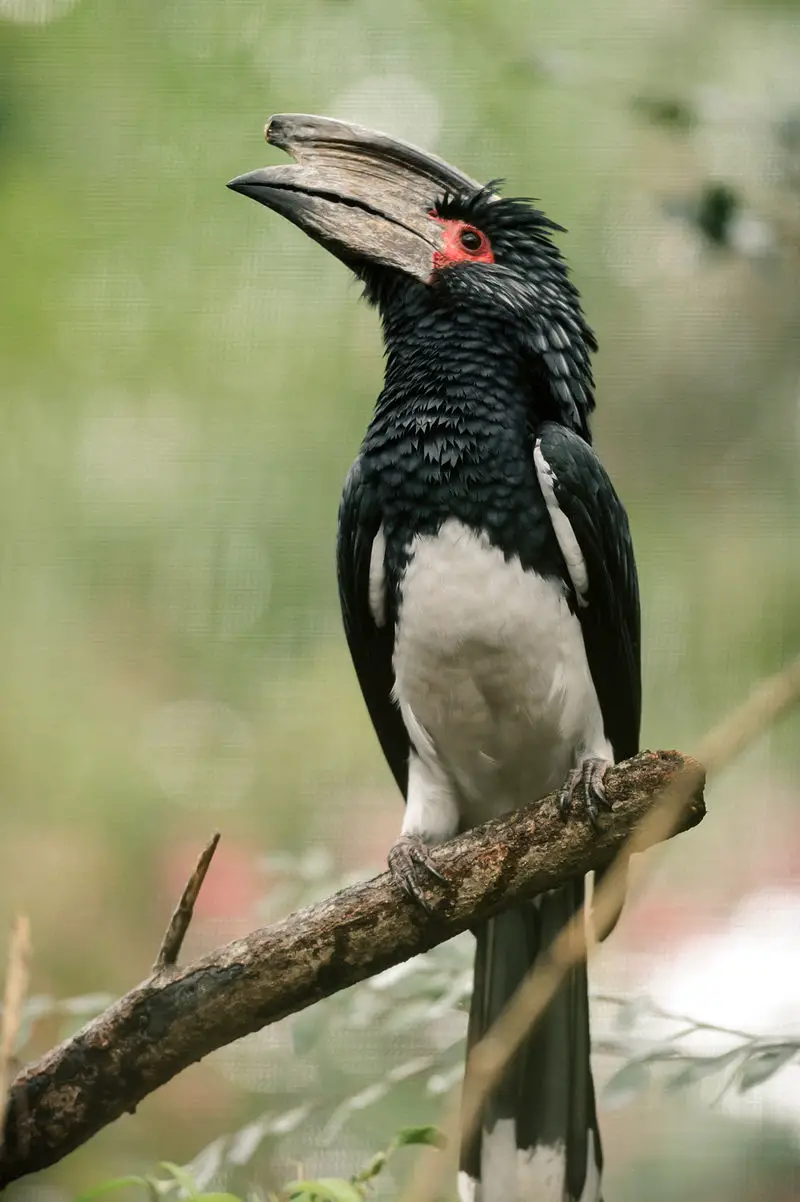
The Trumpeter Hornbill is a stunning bird, recognizable by its large grey casque on the bill and all-black back. Its average length ranges from 58 to 65 cm, with males being slightly larger than females.
It has brown or red eyes surrounded by pink skin, along with body mass ranging between 0.45 and 1 kgs. This species of hornbill shares many similarities with the silvery-cheeked variety but can be distinguished by its unique coloration patterning.
Inhabiting tropical forests across Sub-Saharan Africa as well as parts of South Asia, these birds feed on small mammals such as bats which they catch in flight. They also eat insects, fruit and other foods that are available in their environment.
The trumpet call made by this species gives it its name; trumpeting loudly during mating season to attract mates or ward off predators.
Scientific classification:
| Kingdom | Animalia |
| Phylum | Chordata |
| Class | Aves |
| Order | Bucerotiformes |
| Family | Bucerotidae |
| Genus | Bycanistes |
| Species | B. bucinator |
30. Moustached Tinkerbird
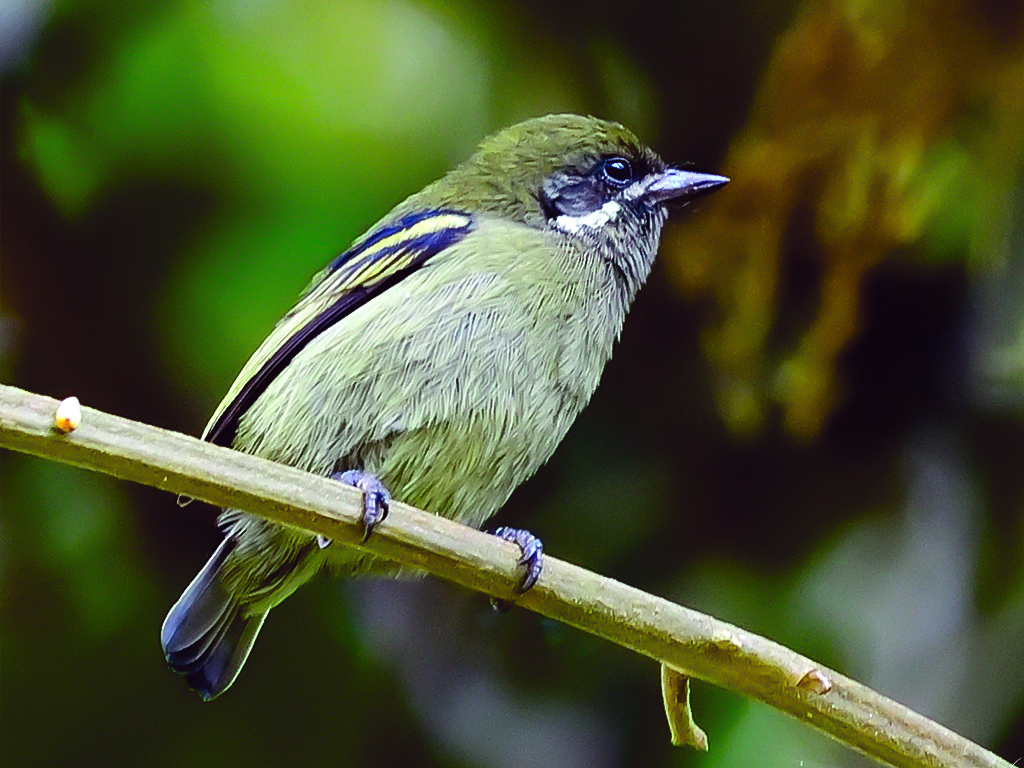
The moustached tinkerbird is a species of bird in the Lybiidae family, native to Kenya, Malawi, Tanzania, Uganda and Zambia.
It has distinctive black barring on its upperparts and bright yellow underparts with red bars; it also boasts an impressive mustache-like crest of feathers which gives this small bird its name.
Its diet consists mainly of fruits and insects gleaned from trees or caught midair foraging flights. During breeding season they form pairs that remain together until their eggs have hatched before going their separate ways again.
This charming little creature may be hard to spot due to its skulking nature but those who do are rewarded with a glimpse into the secret lives of birds living in Africa’s forest canopies.
Scientific classification:
| Kingdom | Animalia |
| Phylum | Chordata |
| Class | Aves |
| Order | Piciformes |
| Family | Lybiidae |
| Genus | Pogoniulus |
| Species | P. leucomystax |
31. Malachite Kingfisher
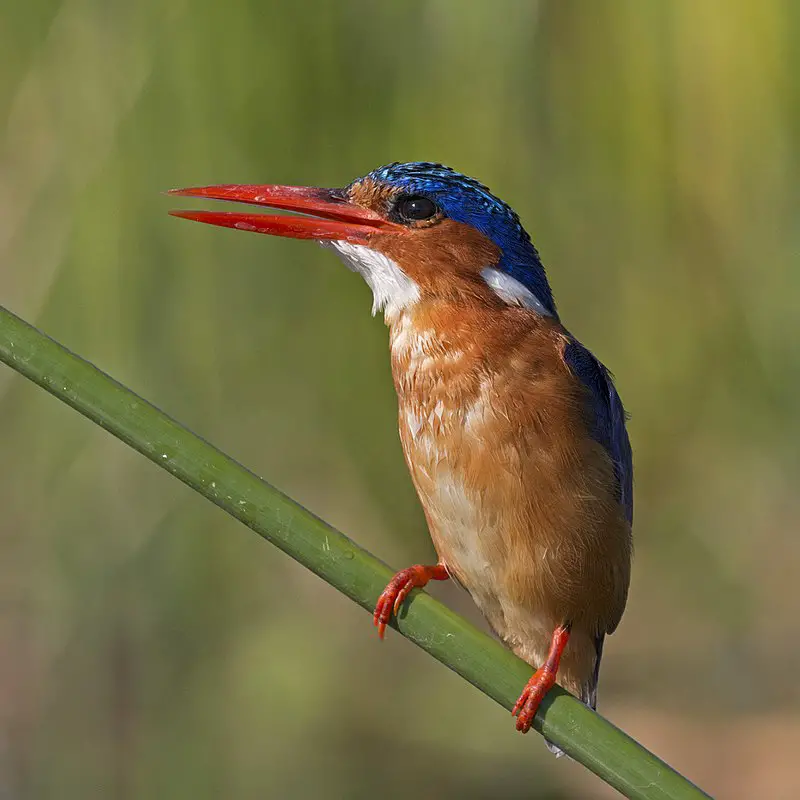
The Malachite Kingfisher is a beautiful bird found in Africa south of the Sahara. It has bright blue wings and tail, with greenish-black upperparts, white chin and breast and orange lower belly.
The species was first described by German naturalist Peter Simon Pallas in 1764 who gave it its binomial name “Alcedo cristata”.
This kingfisher typically inhabits rivers where it feeds on fish, frogs as well as aquatic invertebrates like crustaceans and insects.
Although mainly resident throughout the year, some do make seasonal movements due to climate changes.
These birds are monogamous during breeding season which usually lasts from August till October when they build their nests inside river banks or overhanging vegetation near water bodies.
Scientific classification:
| Kingdom | Animalia |
| Phylum | Chordata |
| Class | Aves |
| Order | Coraciiformes |
| Family | Alcedinidae |
| Subfamily | Alcedininae |
| Genus | Corythornis |
| Species | C. cristatus |
32. Jacanas
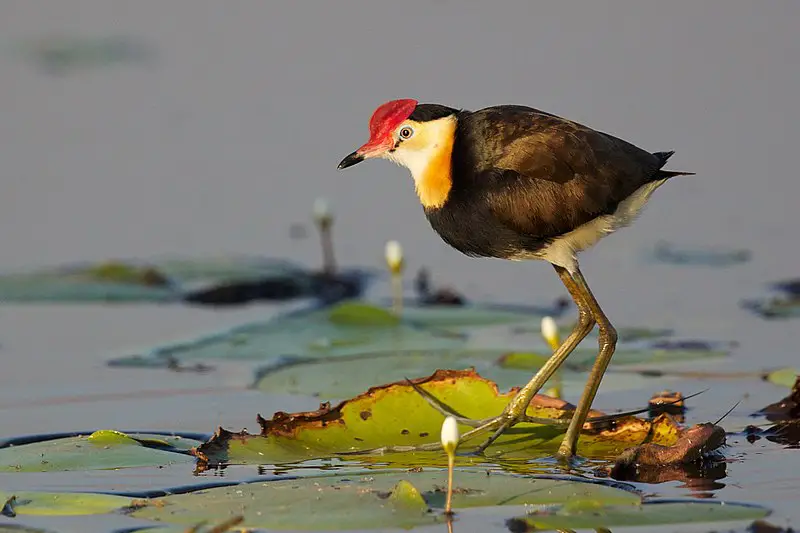
Jacanas are tropical waders belonging to the Jacanidae family. They have distinctive elongated toes and toenails which help them forage on floating or semi-emergent aquatic vegetation.
This adaptation gives them their nickname “Jesus birds” as they seem to be able to walk on water.
The female jacanas are also unique amongst bird species in that they take charge of nest building, incubation and caring for young while males perform courtship displays.
These unusual birds can be found throughout the world’s tropical regions where they inhabit wetlands such as swamps, marshes and shallow lakes with lily pads.
With a wide variety range due their special adaptations these beautiful creatures will surely continue living life at ease around our planet’s warmest waters.
Scientific classification:
| Kingdom | Animalia |
| Phylum | Chordata |
| Class | Aves |
| Order | Charadriiformes |
| Suborder | Thinocori |
| Family | Jacanidae Stejneger, 1885 |
33. Bushshrike
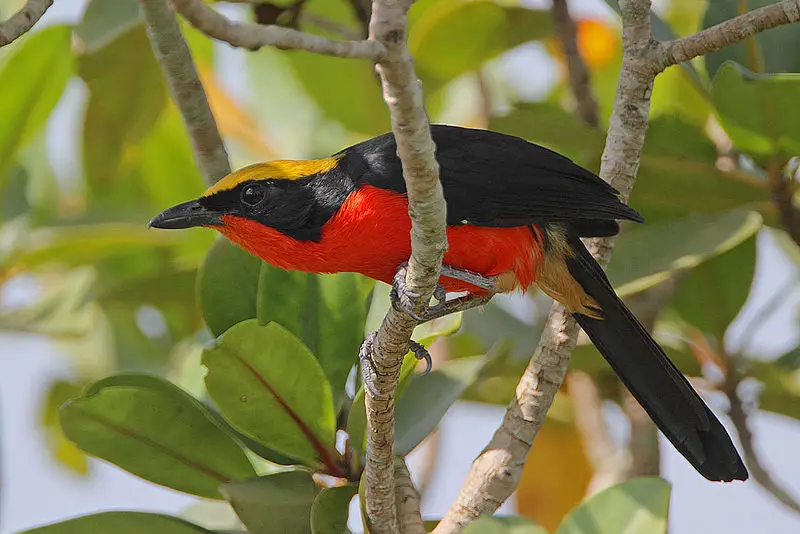
Bushshrikes are a family of small passerine birds native to Africa. Their ruffled back and rump feathers distinguish them from other shrike-like relatives, such as helmetshrikes.
They have bright plumages that vary in color depending on the species, but typically feature black wings with white or yellow markings.
Bushshrikes feed mainly on insects while also occasionally consuming fruits, berries and seeds.
They often hunt by perching atop tall trees and scanning for prey before swooping down upon their target when spotted.
During breeding season males sing melodious songs to attract mates while females build nests in dense foliage near the forest floor using sticks, leaves and grasses lined with soft mossy material or fur plucked from dead animals.
Scientific classification:
| Kingdom | Animalia |
| Phylum | Chordata |
| Class | Aves |
| Order | Passeriformes |
| Superfamily | Malaconotoidea |
| Family | Malaconotidae Swainson, 1824 |
34. Lilian’s Lovebird
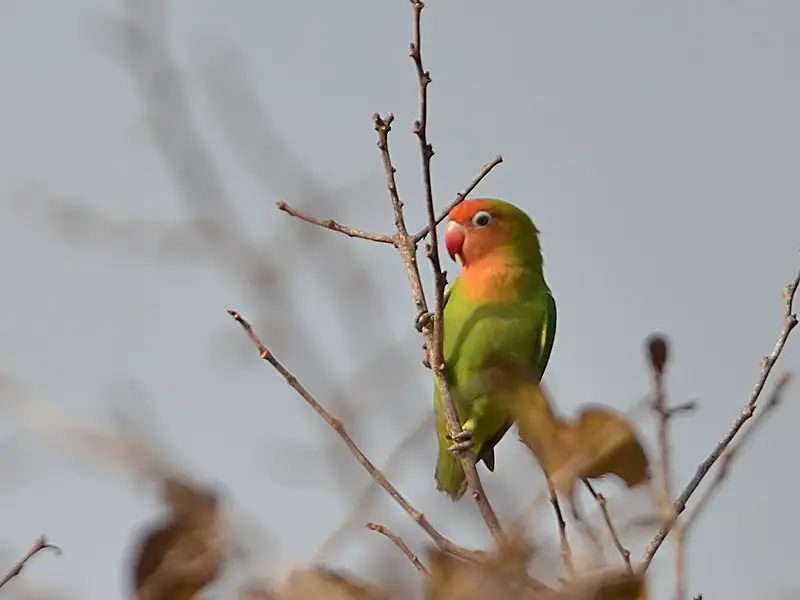
Lilian’s lovebird is a small African parrot species of the lovebird genus, known for its vibrant coloration. It is 13 cm (5 inches) in length and mainly green, with orange on its upper chest and head as well as white highlights across its wings and body.
In captivity it can be difficult to breed due to their rarity; however they are very social birds that bond strongly with their owners when treated properly. They have relatively quiet voices making them great family pets for those who cannot handle loud noises from other bird species.
Lilian’s Lovebirds make excellent companions enjoy activity such as playing chase or swinging on swings, so having plenty of toys available will keep your pet entertained.
Scientific classification:
| Kingdom | Animalia |
| Phylum | Chordata |
| Class | Aves |
| Order | Psittaciformes |
| Family | Psittaculidae |
| Genus | Agapornis |
| Species | A. lilianae |
35. Stierling’s Woodpecker
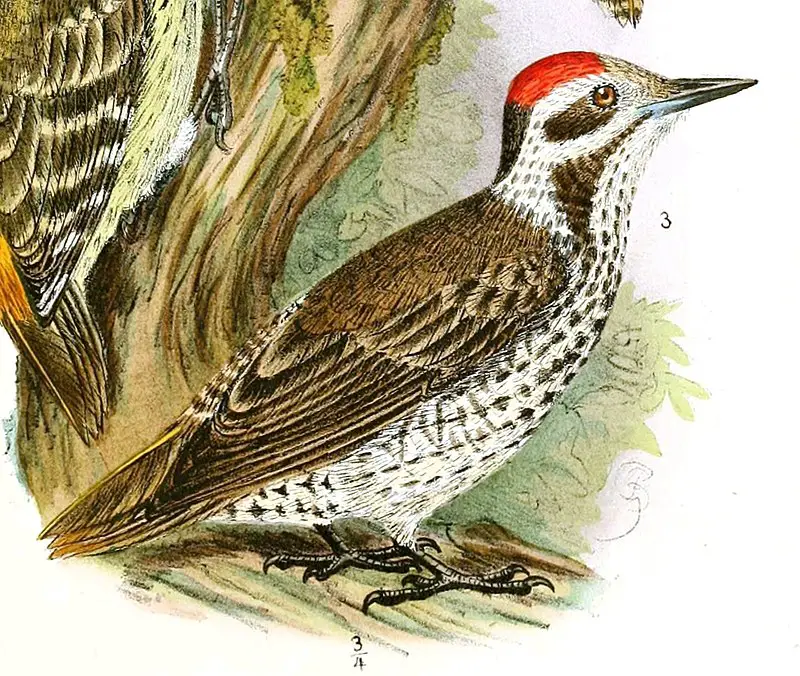
Stierling’s woodpecker is a species of bird found in Malawi, Mozambique and Tanzania. It inhabits the Eastern miombo woodlands ecoregion in tropical dry forests where it feeds on insects that are hidden beneath tree bark or inside crevices.
The bird grows up to 17.5 cm long and has stripy black-gray plumage with white spots on its wings, sides and tail feathers. The Stierling’s Woodpecker is named after German ornithologist N. Stierling who collected specimens for scientific purposes during his travels around Africa at the turn of the 19th century.
This species faces an uncertain future due to habitat destruction which threatens its survival; conservation efforts need to be implemented if we want this beautiful creature to remain part of our planet’s biodiversity.
Scientific classification:
| Kingdom | Animalia |
| Phylum | Chordata |
| Class | Aves |
| Order | Piciformes |
| Family | Picidae |
| Genus | Dendropicos |
| Species | D. stierlingi |
36. Chestnut-Backed Sparrow-Weaver
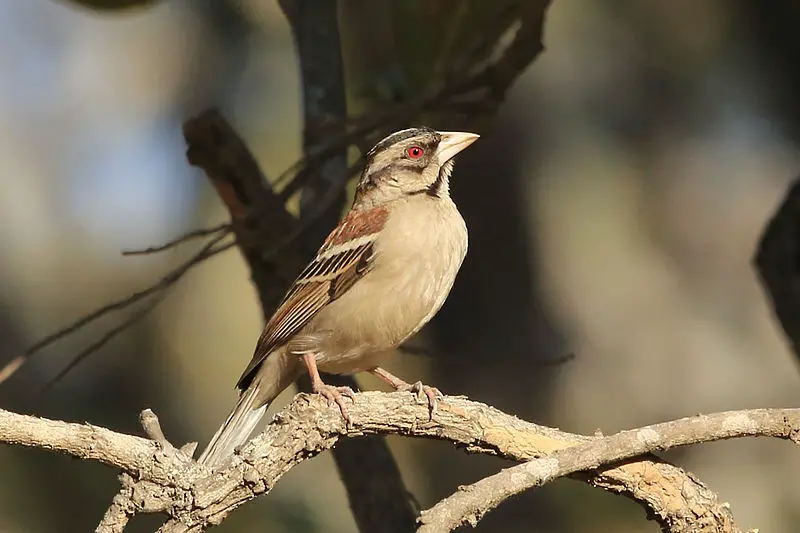
The Chestnut-backed sparrow weaver is a species of bird belonging to the Ploceidae family. It can be found in southern Africa, spanning from Angola and Congo to Zambia and Malawi.
This small bird has a chestnut brown back with white spots along its wings, as well as black feathers on its head which form a crest shape when raised. Its underbelly is generally yellow or light orange in coloration.
The Chestnut-backed sparrow weaver mostly feeds on seeds but will also eat insects during breeding season for extra nutrition for their young chicks.
They are known to build nests together in large colonies near each other due to lack of predators within these areas; however they become aggressive towards one another if food sources run low around nesting sites.
Scientific classification:
| Kingdom | Animalia |
| Phylum | Chordata |
| Class | Aves |
| Order | Passeriformes |
| Family | Ploceidae |
| Genus | Plocepasser |
| Species | P. rufoscapulatus |
37. Painted-Snipe
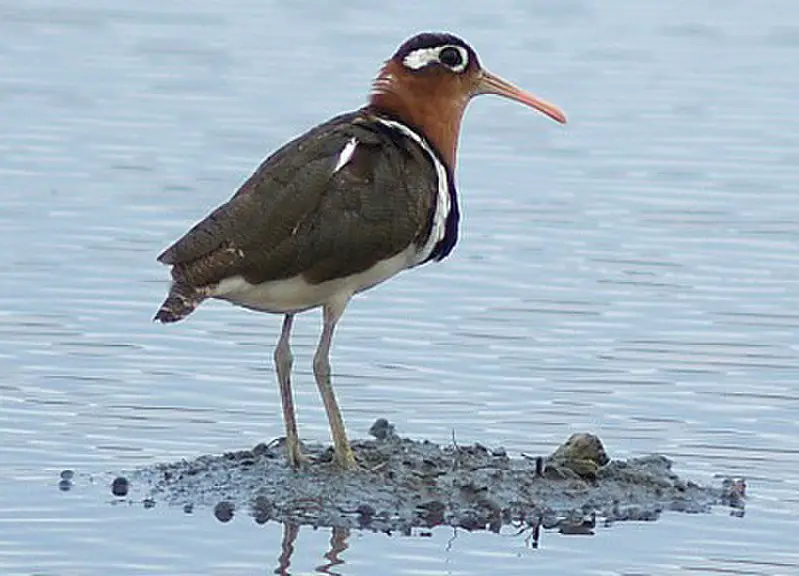
Painted snipes are beautiful and unique wading birds found in the Rostratulidae family. They have short legs, long bills, and a striking plumage which distinguishes them from true snipes.
Males tend to be smaller than females with duller overall coloration. There are three species of painted snipe.
The Greater Painted Snipe, Lesser Painted Snipe, and Australian Painted Snipe – all three have different habitats ranging from wetland pools to grasslands or mangroves depending on their region.
These birds feed mainly on earthworms but also consume insects, crustaceans and plant material when available.
As they rely heavily on wetlands for breeding purposes it is important that we protect these precious habitats so that this special bird can continue to thrive.
Scientific classification:
| Kingdom | Animalia |
| Phylum | Chordata |
| Class | Aves |
| Order | Charadriiformes |
| Suborder | Thinocori |
| Family | Rostratulidae Coues, 1888 |
38. Heliornithidae
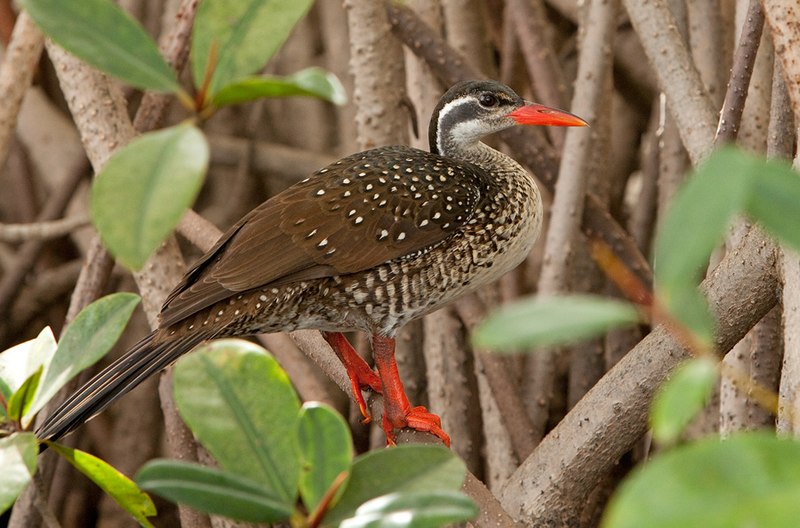
Heliornithidae, commonly known as finfoots, are a small family of tropical birds found in South America and Africa. They have webbed feet like grebes or coots, long necks, slender bodies and broad tails with sharp pointed bills.
Their diverse calls include whistles, squawks and croaks which they use to communicate with each other.
Finfoots feed mainly on fish but also consume insects such as water beetles and dragonflies near the surface of waterbodies.
They nest around rivers or lakes where there is plenty of cover from predators such as eagles or hawks.
During breeding season males can become quite territorial defending their territories against intruders by chasing them off aggressively using loud noises or even physical contact if necessary.
Scientific classification:
| Kingdom | Animalia |
| Phylum | Chordata |
| Class | Aves |
| Order | Gruiformes |
| Family | Heliornithidae GR Gray, 1840 |